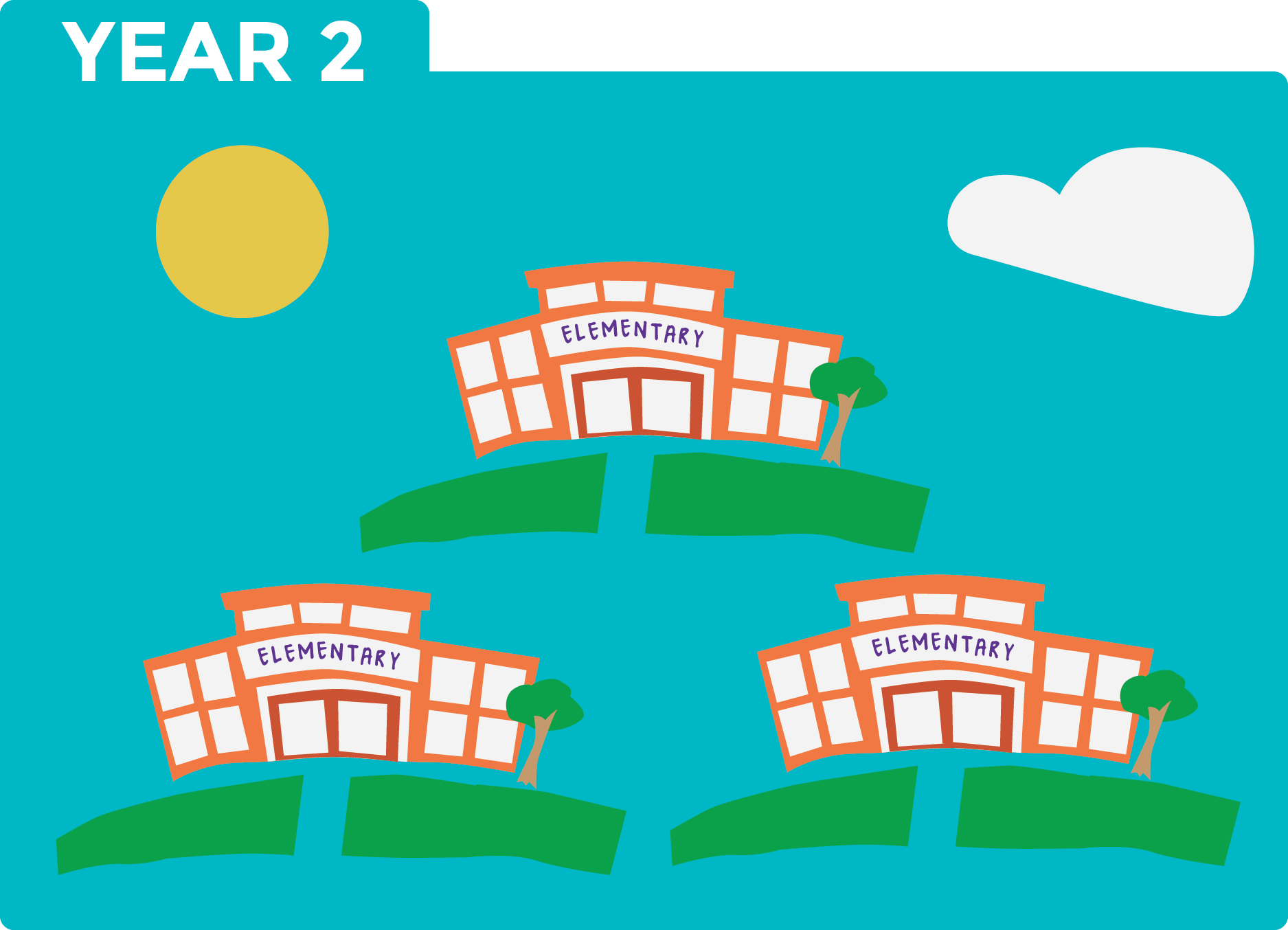The TMA project aims to create mathematical computation tools that enable students to learn and demonstrate algebraic reasoning prior to learning about formal algebraic proofs. The tools are created in collaboration with leading mathematics educators. They are being developed and tested using our tablet-based Classroom Learning Partner (CLP) software and in conjunction with our NSF-funded project, INK-12: Teaching and Learning Using Interactive Ink Inscriptions in K-12. TMA makes use of CLP's ability to support the creation and manipulation of visual representations, in particular those used in multiplication and division; the replay of students’ interactions in creating the representations; and the sharing and display of student work as the basis for class discussion.
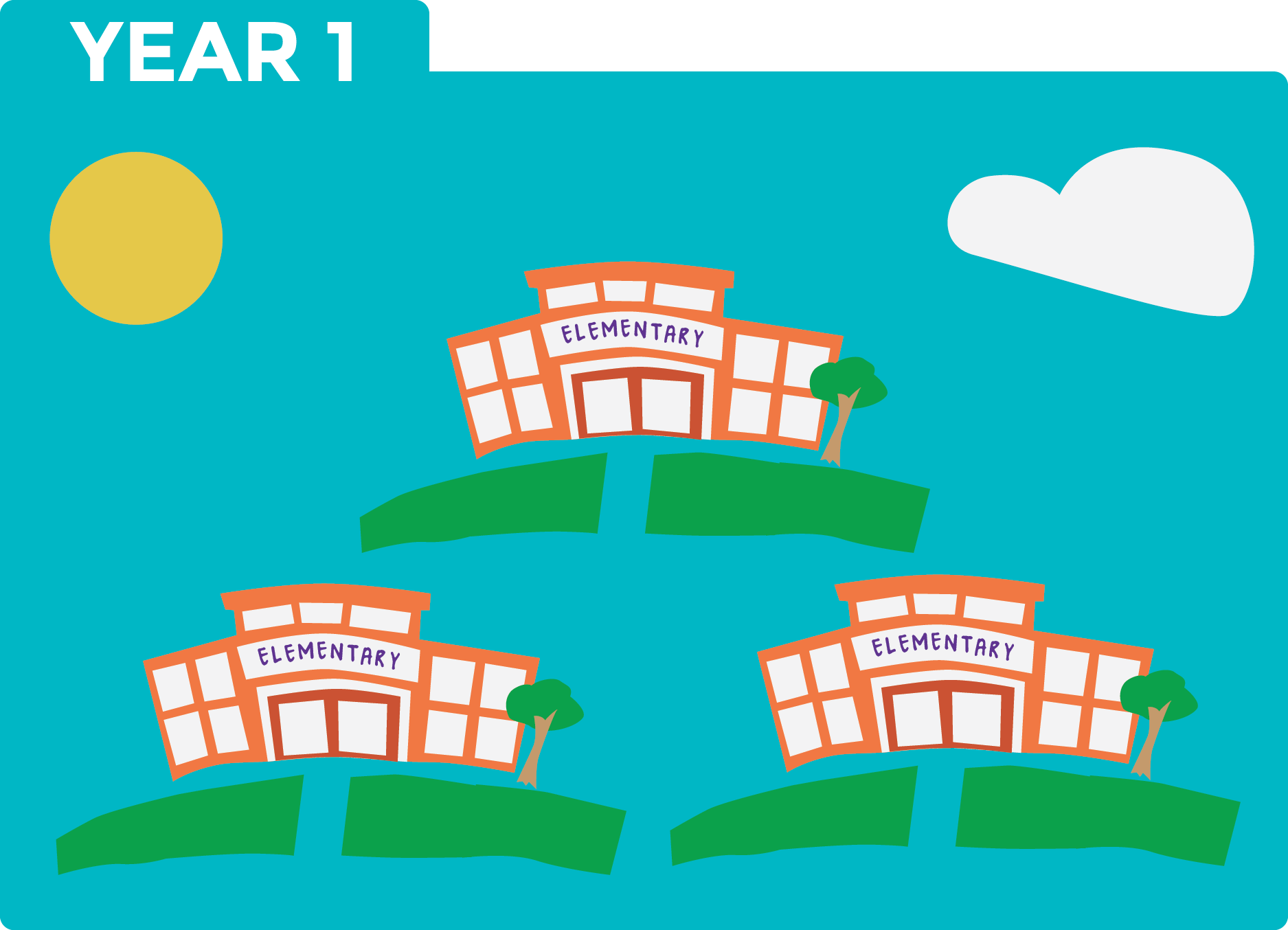
Below we describe the tools we have developed, our experiences with them in two classrooms, reflections on these design criteria and plans for the next phase. The proof construction software was tested in two classrooms in June, 2013. This section contains a report of two classroom trials.
The 3rd grade class was part of the Routines project, led by Russell, Schifter and Bastable, and was thus familiar with the process of using representations to prove generalizations about arithmetic operations. They had also had considerable experience using arrays to visualize multiplication and division problems. The first three days the students primarily practiced using the array creation and cutting tools and the animation tools. The fourth day they worked on two proofs that required them to coordinate using all of the tools they had learned about in the previous three days. The student work discussed here is from the fourth day.
We visited this 4th and 5th grade special needs class because we wanted to know if the new cutting and animation software tools were accessible to struggling students: Could the students understand the concept of cutting arrays? Could they easily move the new small arrays on the screen? Could they understand the concept of creating an animation that explained their solution to a problem? We had worked with these students on several previous occasions so the students were familiar with the CLP software and needed no introduction to using the pen or creating arrays. Unlike the students in Trial 1, these students had not been introduced to the idea of proof, so on the first day, we introduced the new software features—the cutting tool and animation—in the context of math problems familiar to the students, namely division with remainders. Then on the second day we introduced the idea of proof and had the students create animations for proofs similar to some of the proofs in Trial 1.
While students were able to use the tools quite facilely, their solutions had only minimal variability, due to the narrow range of tools that we provided to them. There was more variability in their solutions to the second problem in Trial 1 (What happens when you subtract 1 from one of the factors in a multiplication problem?), but even there, most solutions were similar. Our next steps to provide students with more expressive options will be to integrate more tools with the animation capability and to develop a fuller range of tools to construct and manipulate arrays.
Adding array construction tools to the set of tools students have available may make it possible for students to express more "wrong" ideas – such as cutting off a single unit from an array, rather than cutting off a row or column, as JA in Trial 1 wanted to do. There is an interesting educational dilemma encapsulated in this design question. Some digital tools lead students to "correct" ideas but may short circuit the confusion/re-conception process that may ultimately lead to deeper understanding. In this case, if JA had been able to just take off one unit from her array to show her understanding of "subtracting 1 from a factor" (which she would have been able to do with physical cubes), the classroom conversation would have been different. Would this have been "better" for her learning? For the class as a whole? Having more flexible tools might allow us to examine this question in more depth.
The animation tools worked well, especially after the modifications described above, and students learned to use them quickly, even in the special education classroom in Trial 2. While we don’t have direct comparisons, our impression is that these tools enabled students to express mathematical equivalences more easily than they could with either pencil and paper, manipulatives or static drawing tools.
Although we had originally hypothesized that adding the ability for students to record an audio explanation to go along with their animation would enhance their ability to explain their thinking, we did not implement such a feature. One reason was that we realized in the design phase that it would be quite difficult for students to synchronize their verbal explanations with the animation. In general, the animations were quite brief and lasted much a much shorter time than it would take for a student to describe what was happening. As described above, the issue of play-back speed was a complicating factor in and of itself, and we decided that complicating it by adding an interaction with audio would be more of a burden than a help. Most of the discussion of students’ work in the classroom involved students’ reading their explanations from the screen, then answering questions from the teacher or other students. In experimenting with audio explanations previously, we had discovered that it was quite difficult for the entire class to hear an explanation played on the teacher’s machine.
There are students, of course, who find writing daunting and they might particularly benefit from an audio recording capability, especially for work that the teacher will be reviewing outside of class when students are not available to answer questions about their animations.
While our goal is to provide students with tools to prove generalizations about arithmetic operations, in this first round of classroom testing students mostly worked with specific instantiations of general rules. For example, in Classroom 1, while Problem 2 was phrased in full generality: "What happens when you subtract 1 from one factor in a multiplication problem?" students actually worked on the problem in the context of 6 X 4. And, while they were generally successful in their use of the technology and cogent in their arguments about the specific problem, there was no obvious way for them to use the technology to make the general argument, as they could only create specific arrays using our tools, by specifying the number of rows and columns. In order to do general proofs, students need some kind of representation that indicates that the actual number of rows and columns doesn’t matter; rather, the proof is about the structure of the numbers and the effect of the structural manipulations on that structure. Of course, this is what "x" and "y" connote in formal algebraic proofs.
In conversations with the Classroom 1 teacher, we have begun to design a new feature that would support students’ ability to make more general arguments. She reported that when they talk about proofs, her students sometimes use their hands to cover part of the representation of a number that they’ve constructed of manipulatives such as Unifix cubes in order to indicate that it doesn’t matter how many cubes are in the "covered" part of the number. We will create a similar "hand" or "cloud" (we haven’t figured out the right metaphor yet) that will allow students to distinguish between the critical parts of the structure of a number (i.e. those that are important to the proof) and those indeterminate parts that are "variable.""

In this trial with 4th graders, we worked with the same teacher who hosted our trial last year. She has been part of the NSF-funded Routines project upon which our perspective on early algebraic reasoning is based for several years. Thus, she has had extensive experience guiding elementary school students in making generalizations about arithmetic operations. In our work with her last year, students were quite successful using the animation software to make statements about arithmetic equivalences, but never got to making arguments about generalizations about the way operations worked across "all numbers." Our goal this year was to engage them in a technology-supported conversation about a generalization. We were successful in our attempts; details of the results of this trial are included here.
Northeast Elementary School in Waltham, MA • 4th Grade • 18 Students • 1 Day
This was our shortest trial, and our primary goal was to see how quickly students could learn to use the animation software to describe arithmetic equivalences. Students in this class had already used our software for several days, but had not encountered the animation system. In one period of approximately an hour, almost all students in this class were successful in using the animation to show the equivalence of 3 X 4 and 2 X 6 by creating an array representation of 3 X 4 and modifying it to become an array representation of 2 X 6.
Northeast Elementary School in Waltham, MA • 3rd Grade • 21 Students • 4 Days
In this trial, we worked with third graders for the first time, our goal being to see whether younger students a) could learn to use the software in a short amount of time and b) could understand the use of animations to demonstrate mathematical equivalences. While we were in this third grade classroom for four days, two of the sessions were very short, so our total time working with these students was only about three hours. In that time, almost all of the students in this class learned to use the array creation and manipulation tools and the animation system fairly fluently and most of them successfully created an animation to show that 3 X 4 = 2 X 6. A few of them successfully created an animation to show that 5 X 4 was equivalent to (5 X 2) X 2.
Most of the class in became convinced that the equivalence [NX4=(NX2)X2] would work for any number for A. While they were not able to create an animation to show the equivalence for "any number," it was clear that the students were basing their arguments on the examples they had just worked. Students successfully made the crucial distinction between the parts of the equivalence that could change ("it would be the same for any number"; "the first number could be either even or odd") and the parts of the equivalence that could NOT change ("as long as the 4 and the 2X2 is the same"; "because 2 is half of 4, so you just double it").
These three trials demonstrated that third and fourth grade students could learn to use the array tools and the animation system in a period or two and could quickly be meaningfully engaged in exploring equivalences among multiplicative structures.
Our research has indicated that with appropriate digital capabilities (e.g. our system’s combination of array creation and manipulation and animation tools), upper elementary students are capable of constructing proofs of specific mathematical equivalences and, with pedagogical support, can generalize these equivalences to universal rules about mathematical operations. Furthermore, this pedagogical sequence can take place over just 3-4 days; our work suggests that the digital representational tools we have provided allow students to understand the concepts more quickly and flexibly than they could without them.
Students in our field test classrooms were enthusiastically engaged in authentic mathematical reasoning; several of them participated more actively and energetically than they usually do in math class, according to their teachers. Some of this enthusiasm was clearly due to the presence of computers, but we hypothesize that students’ engagement was also increased by our pedagogical approach, in which we presented authentically interesting mathematical dilemmas with the potential for discovery and the pleasure of "getting it." We believe that experiences such as these can have long-term consequences for students, potentially changing their mathematical disposition and their desire to continue to study mathematics as their education proceeds.
These results are a testament to our design process, to elementary students’ remarkable fluency with digital media, and to these students’ interest in thinking about the structure of numbers and operations.

The following reports on software development and a classroom trial (including the curriculum flow, students’ approaches to the challenge of creating a proof for Nx4=(Nx2)x2, and trial results), and suggests changes to the software based on this trial.
Our technology development focused on a new software tool, the Fuzzy Array tool, for supporting mathematical proof, new and improved UI features, and integration of the animation creation functionality with machine analysis of student interactions, which was developed for the DRK-12-funded project Collaborative Research: INK-12: Teaching and Learning Using Interactive Ink Inscriptions (DRL-1020152, DRL-1019841).
Northeast Elementary School in Waltham, MA • 2nd Grade • 18 Students • 5 days
These students had been using the Math in Focus curriculum, and, in addition, the math coach had been visiting their classroom regularly to support their teacher. The relatively ambitious goal of the 5-day trial was to have the students use the new "fuzzy array" tool to demonstrate a generalization about multiplication. In previous classroom trials in this project, we had worked with third and fourth grade students, so this was a bold choice, but we were encouraged by the math coach, who felt that this particular group of students was up to the challenge. The coach participated in planning the trial and co-taught the lessons with one of the PIs.
In order to have this class of second-graders reach our goal of creating a generalized representation-based proof using our new Fuzzy Array tool, we designed the following curriculum sequence:
While there were many memorable moments and insightful comments from these second-grade students, we focus here on the variety of approaches students took to the final challenge, which required them to move from animations that used specific numbers to animations that were intended to be true for all numbers. Specific students’ work is described below.
Many students started with the same animation they had created for the last specific number they worked on, e.g., 5x4. Earnest, whose work is shown from beginning to end in Figures 1a-d, actually did the proof for the specific problem 5x4, then deleted those arrays and created the same structure with a Fuzzy Array as his general proof.
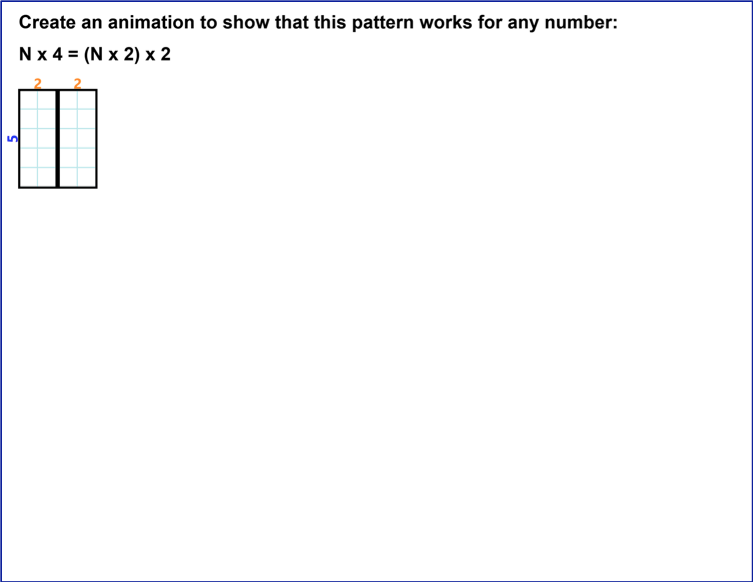
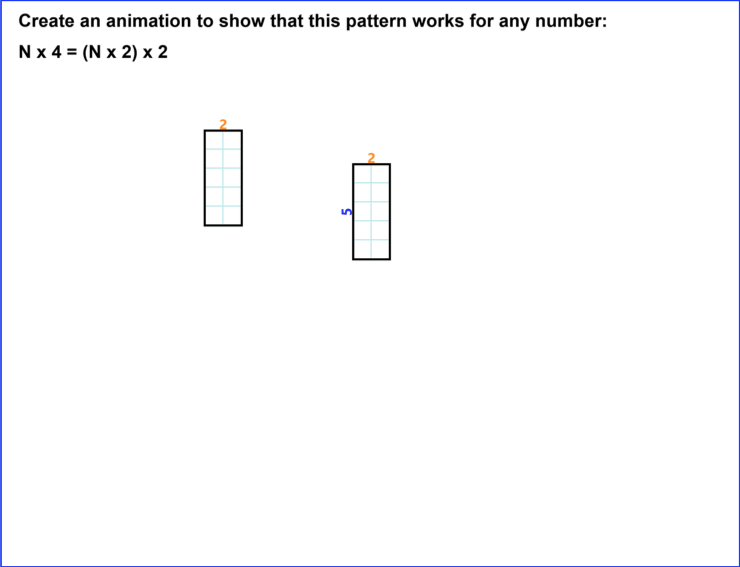
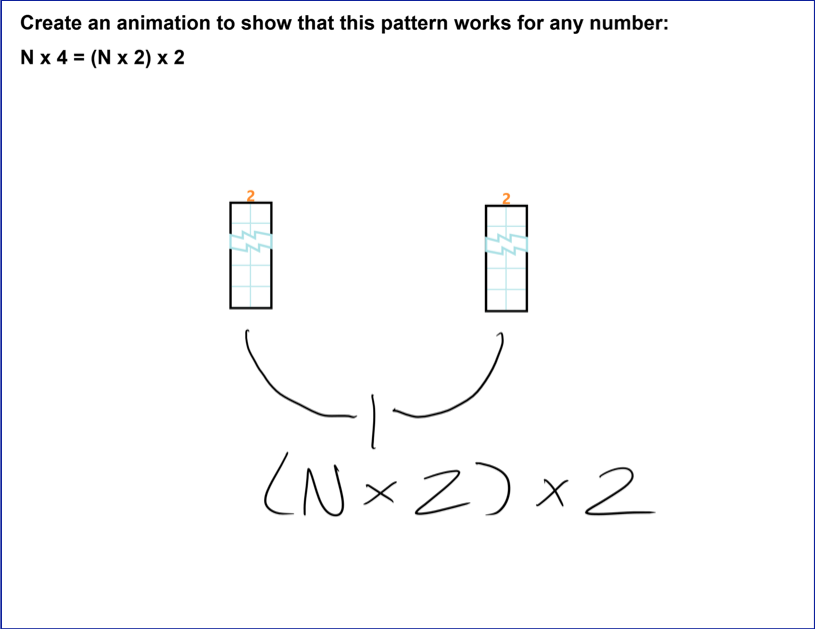

Like most students who took this approach, Earnest first hid rows in his 5x4 array, turning it into an Nx4 array, then cut it into two Nx2 arrays. He "read" (Nx2)x2 as two Nx2 arrays.
Several students, including Faith, explicitly labeled the indeterminate dimension as "N." The final screen of her animation work is shown in Figure 2.
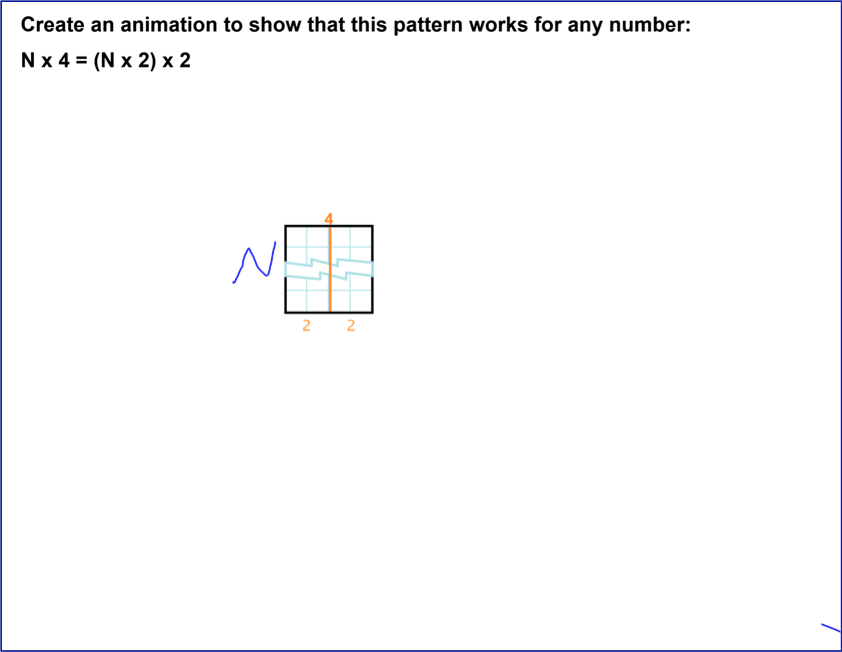
Some students found it difficult to read the obscured rows in the middle of the array as an unknown and persisted in counting the squares that remained visible. This led to work like Emma’s final screen, shown in Figure 3, in which she labeled various parts of the array representation, but may not have gotten the main point.
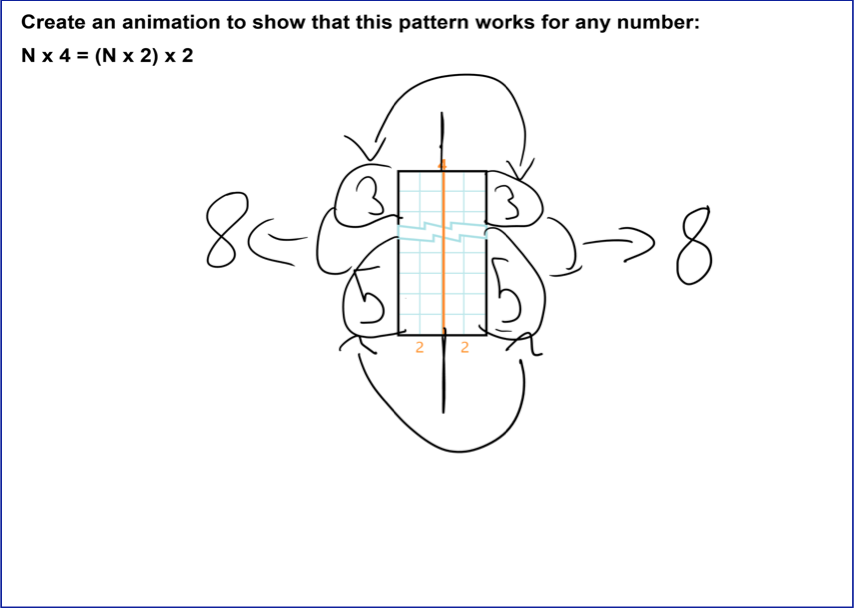
George’s final screen (Figure 4) also shows an interesting reading of the array with rows hidden. He first created a 8x4, hid rows, cut it into two Nx2 arrays and snapped them back together. He wrote equations referencing the 8x4 array, then added "turned into 5x4=(5x2)x2." It appears he was counting the squares in the array that were still visible after some rows had been hidden.
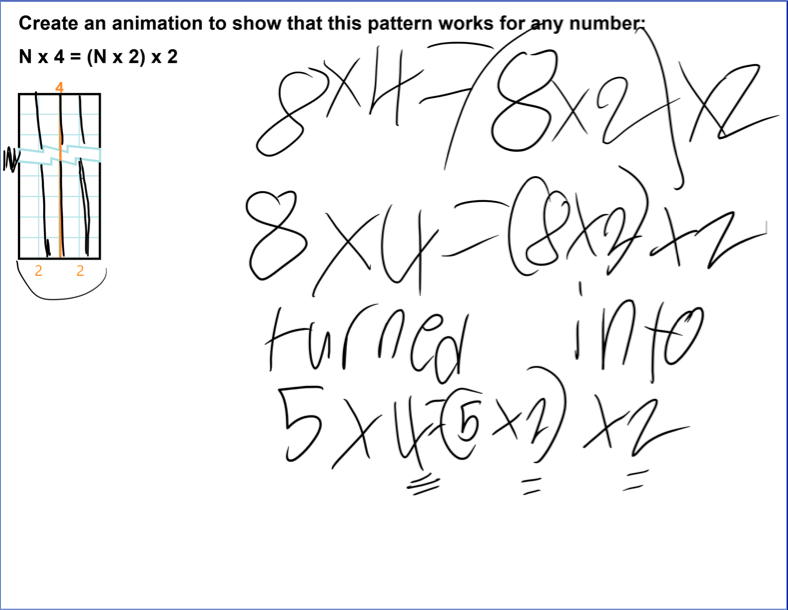
Isaac’s final screen (Figure 5) is even more explicit in its comments on arrays with hidden rows. He was sure that there were 7 rows in his array, but when rows are hidden, the number of rows is supposed to be unknown. So he posed the question, "How to know how many rows are they?" and answers "don’t look!" or "N."
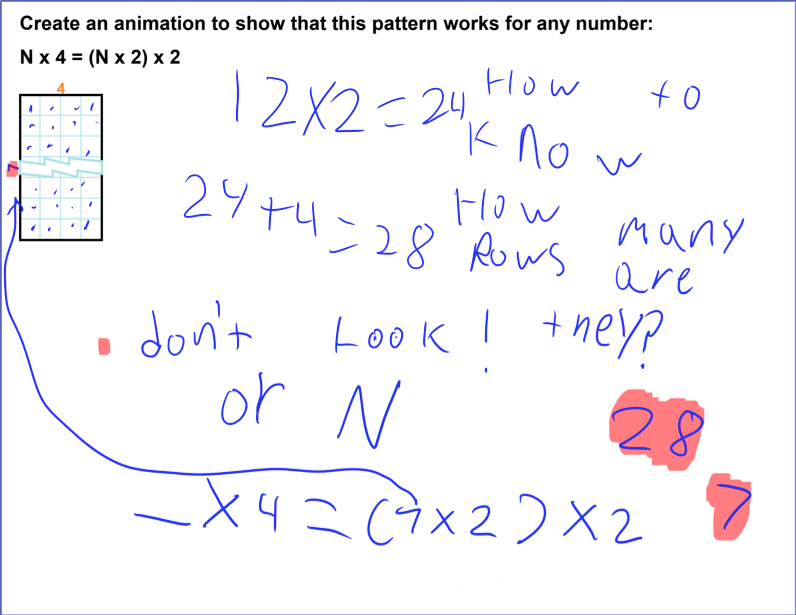
These kinds of mis-interpretations of the Fuzzy Array representation led to some ideas for design modifications to the tool, described below.
In spite of some confusion on some students’ parts, most students were able to articulate why the pattern N x 4 = (N x 2) x 2 would work for any number (although some students wondered if it would work for 0 or for negative numbers) and most of them were able to create an animation that illustrated the generalization using Fuzzy Arrays.
Several students went beyond this, as well. We had hoped to have time to generalize the pattern beyond the relationship between 4 and 2x2 to examples such as Nx6 = (Nx3) x 2, so we had this problem available for students who finished the previous one. About half the students successfully created an animation for this generalization (e.g., Ollie’s in Figure 6).
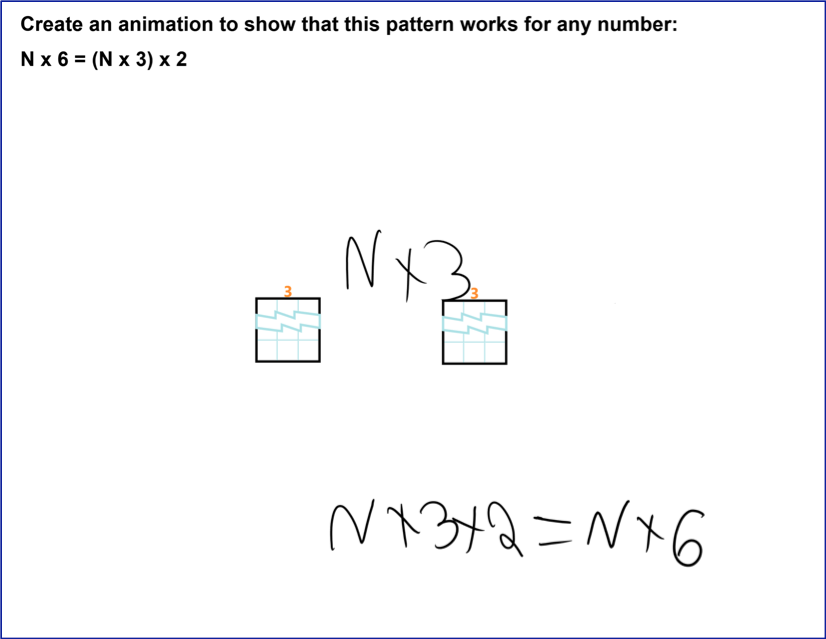
A few even verbalized the realization that this pattern would work as long as the number N was multiplied by on the left side of the equation was even, so that it could be written as 2 x (N/2) on the right side. Our current set of tools, however, was insufficient for representing this "double generalization," as we limited the hiding of rows and columns to a single dimension – i.e. when rows are hidden, columns can’t be and vice versa.
Our original design for the Fuzzy Array was meant to take advantage of students’ comfort with arrays to build toward an ability to generalize about multiplication. We hypothesized that first creating an array with specific dimensions, then making one of those dimensions variable would support students’ thinking about generalization and proof. Students’ use of the Fuzzy Array in our classroom trial suggested some design improvements that should avoid some of the pitfalls we students encounter.We observed that several students attempted to count the number of rows in an array even when rows in the center of the array were hidden and thus missed some of the power of a variable dimension.
We believe that several improvements to the array tool will help students better understand the visual representation: Instead of leaving blank the label for the indeterminate dimension represented by the obscured rows (or columns), display the letter "N" (or a different letter chosen by the teacher) as the dimension Hide the grid lines for the rows (or columns) representing the indeterminate dimension so as to discourage students from counting the rows (or columns); and Enable students to create an array with an indeterminate dimension directly by specifying a letter to one dimension, rather than having them specify a number, then explicitly hide some of the rows (or columns). (See Figure 7 for an example of the improved visual representation.)
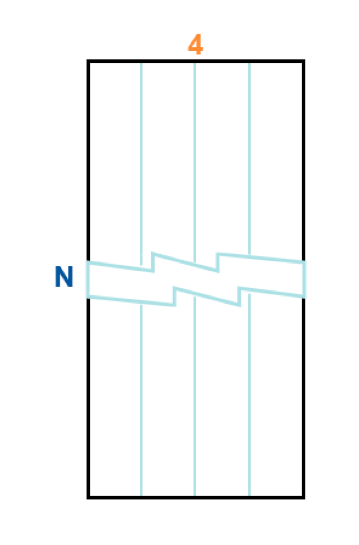

About the School: Inner-city school with students of predominantly African American, Latino and Carribean backgrounds.
The class was part of the Routines project, led by Russell, Schifter and Bastable, and was thus familiar with the process of using representations to prove generalizations about arithmetic operations. They had also had considerable experience using arrays to visualize multiplication and division problems. The first three days the students primarily practiced using the array creation and cutting tools and the animation tools. The fourth day they worked on two proofs that required them to coordinate using all of the tools they had learned about in the previous three days. The student work discussed below is from the fourth day.
In order to solve this problem, students had to create either a 3 X 4 array or a 6 X 2 array, cut it in half and re-arrange the halves to create the other array, recording the transition from one shape to the other in an animation. The proof of the equality of the two expressions is inherent in the fact that, while the shape of the array has changed, there are still the same number of units in the representation. Examples of student responses are below. AL’s animation, shown over three stages from beginning to end, in Figures 1a-c and Video 1, is typical.
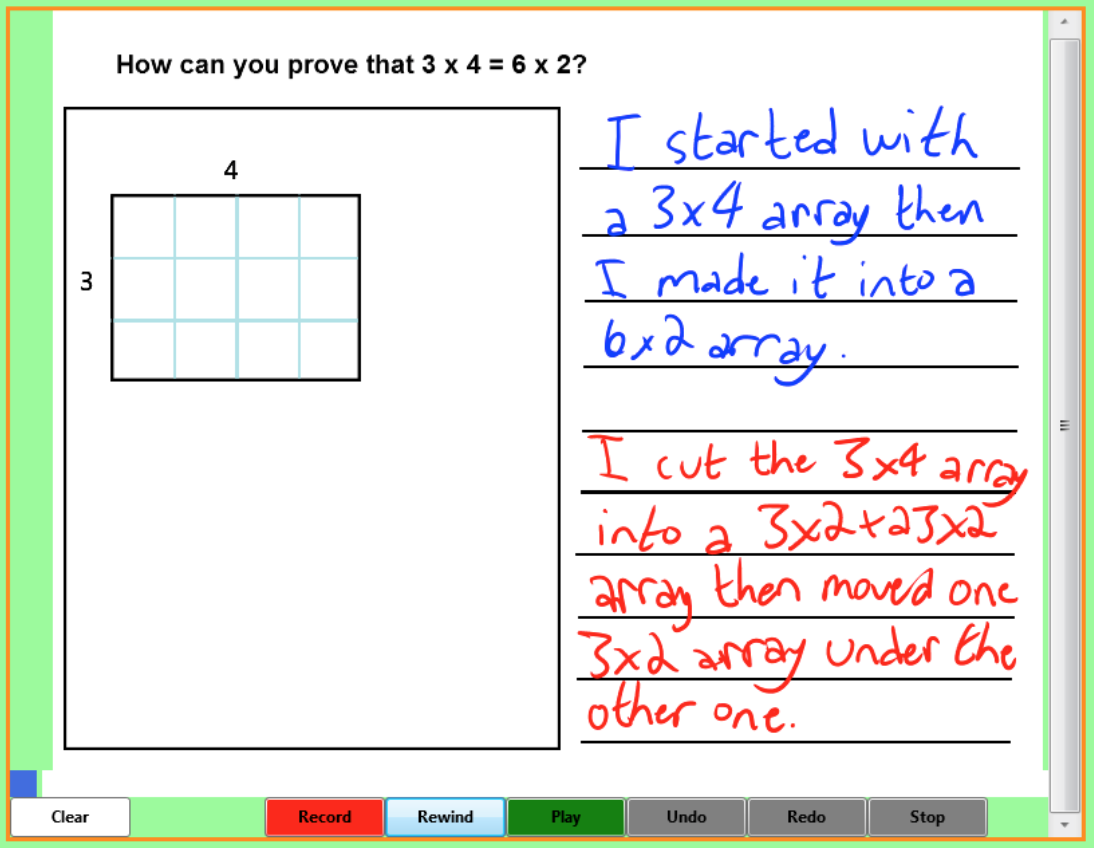
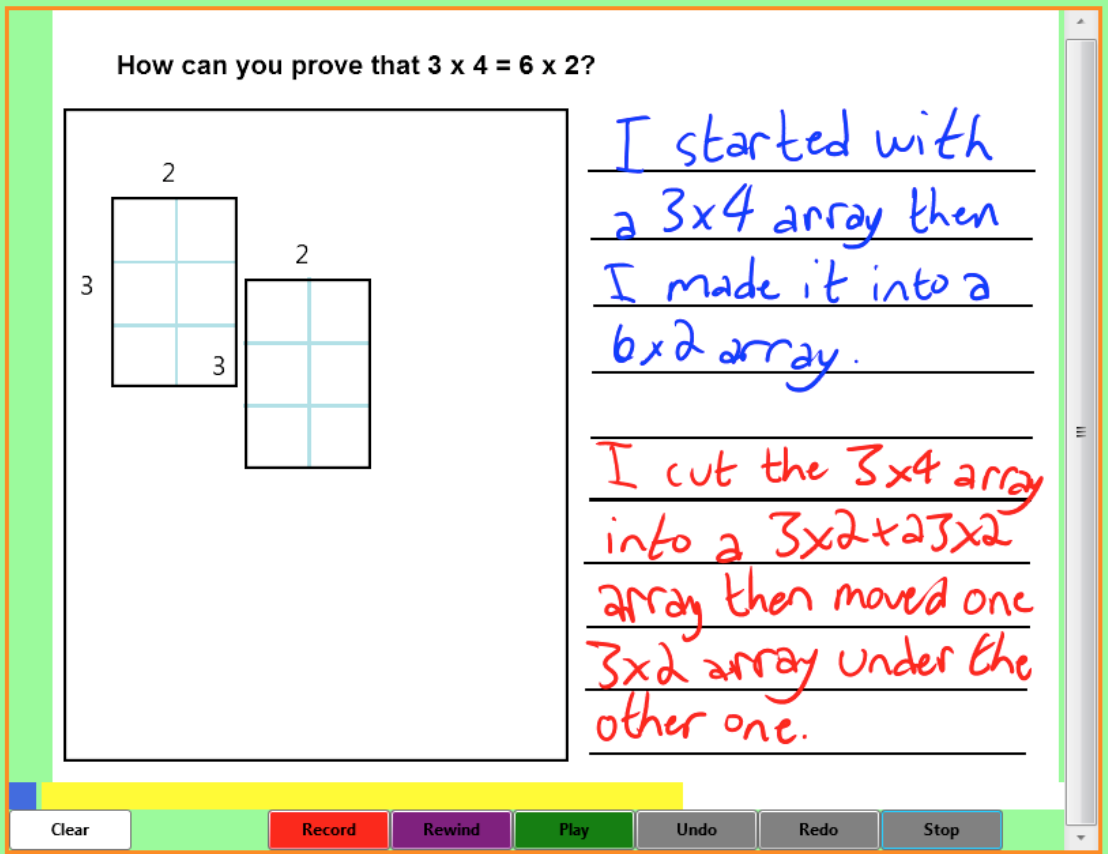
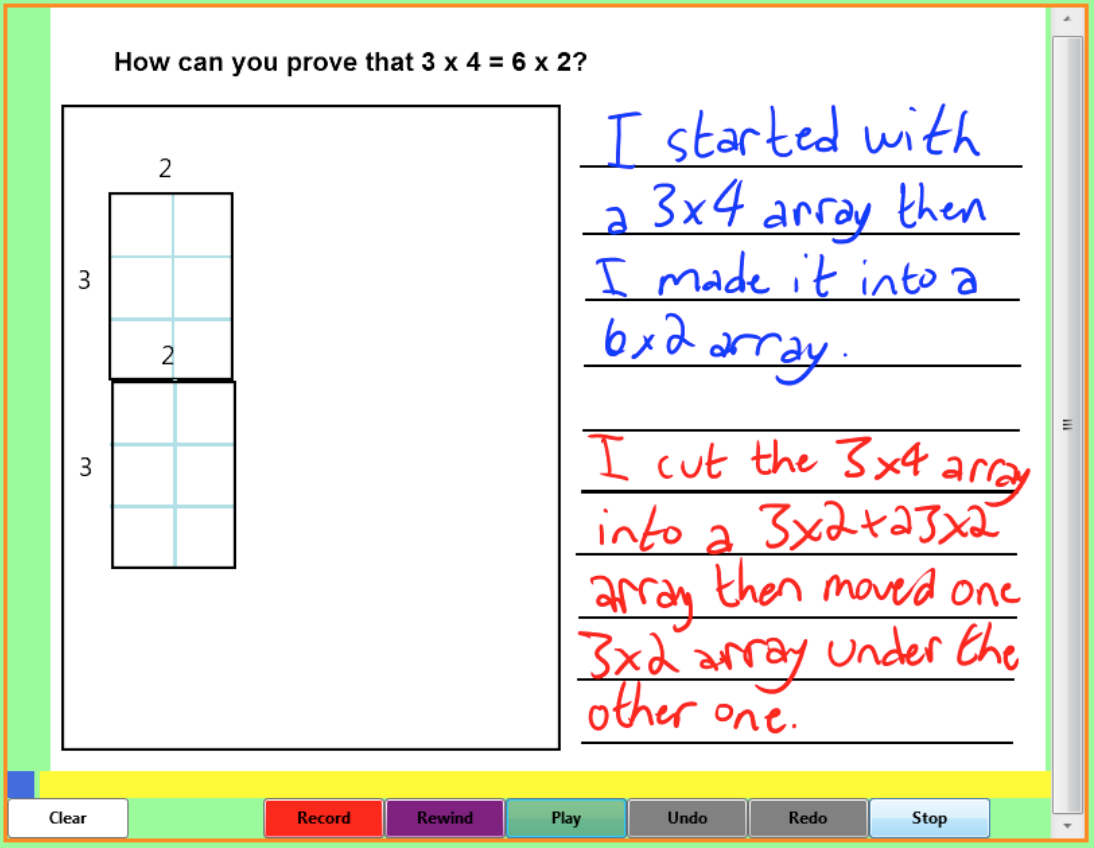
AL began with a 3 X 4 array, cut it into two 3 X 2 arrays and moved one of the smaller arrays under the other small array to create a 6 X 2. While she wrote her explanation after creating the animation, it is not officially part of the animation and thus stays on the page while the animation is playing.
Some students wanted to show the transformation in both directions, i.e. from 3 X 4 to 6 X 2 and from 6 X 2 to 3 X 4. Two examples of this approach are shown below. Figures 2a-c and Video 2 show DO’s animation over three stages from beginning to end.
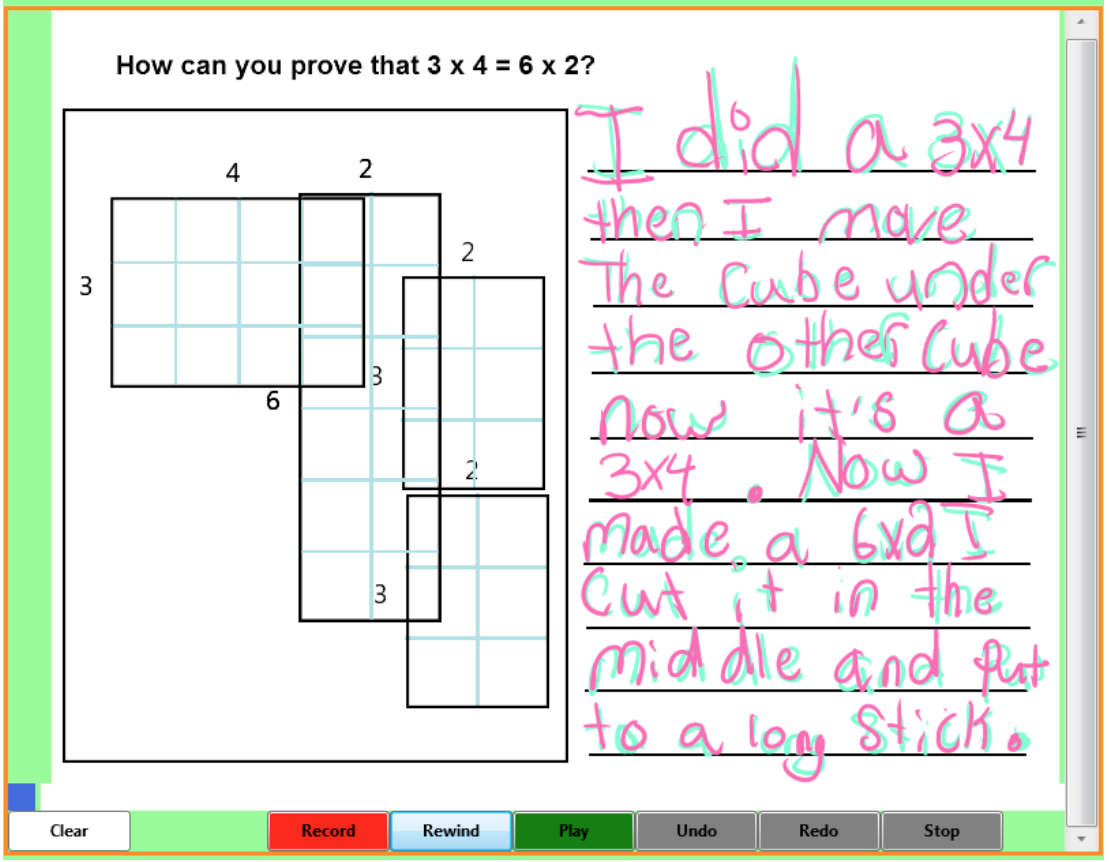
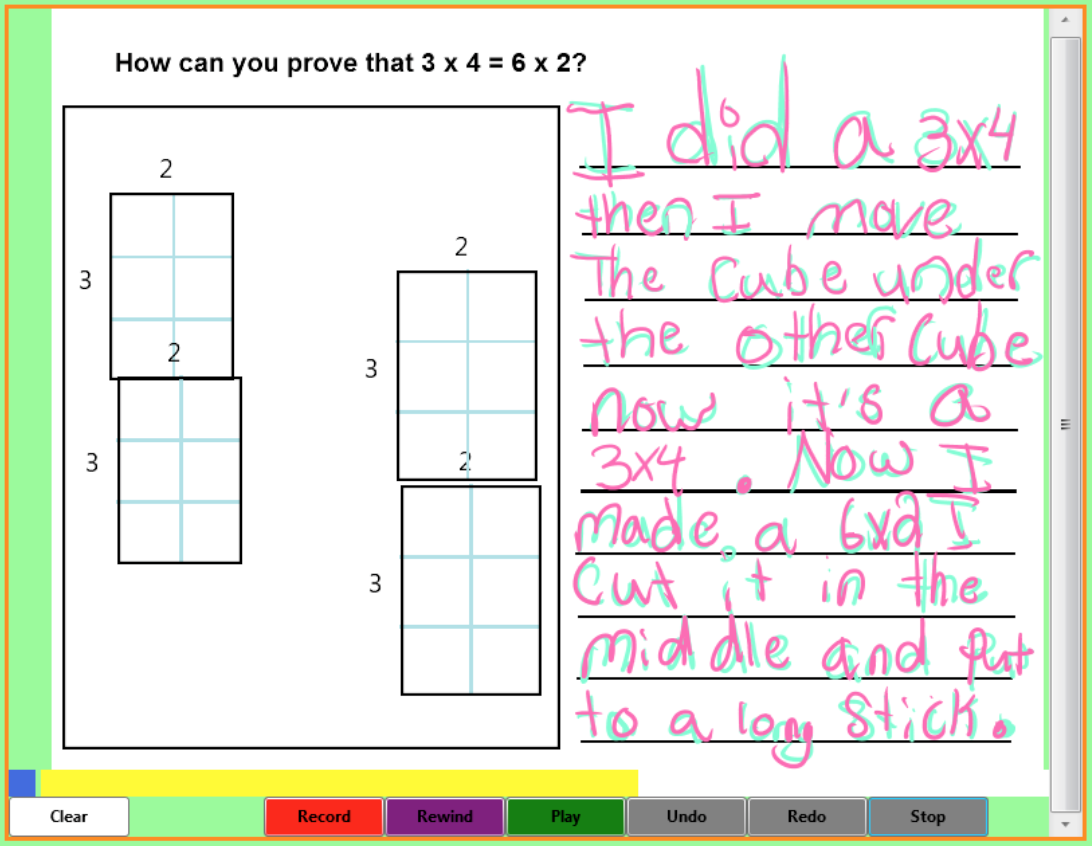
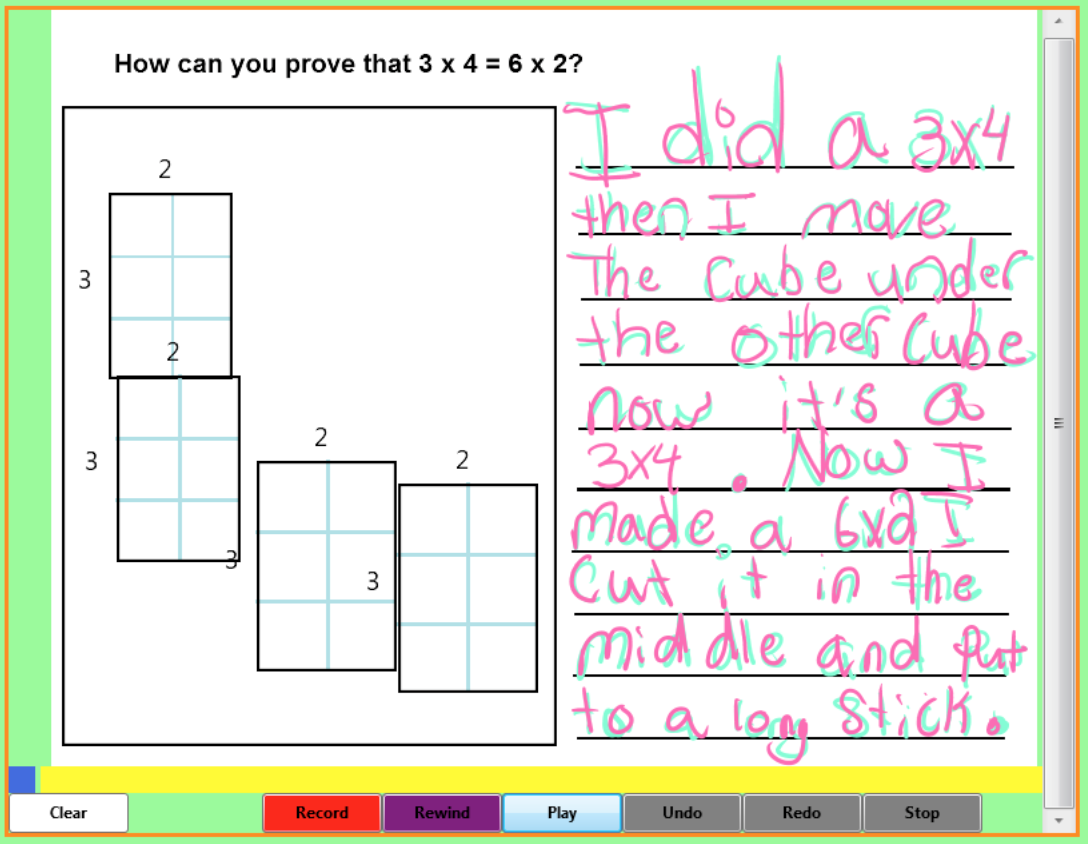
Note that before starting her recording, she created a 3 X 4 array, a 2 X 6 array and two 3 X 2 arrays. Her final screen shows just two arrangements: a 6 X 2 made up of two 3 X 2 arrays and a 3 X 4 made up of two 3 X 2 arrays. Her written explanation includes some vocabulary that had been developed specifically in her classroom (i.e. "stick" to mean arrays that are much longer than wide) but her oral explanation in class was quite clear.
RO went even further in his desire to show that the two arrays represented the same quantity, using color to distinguish the two different arrangements, as shown in Figure 3 and Video 3.
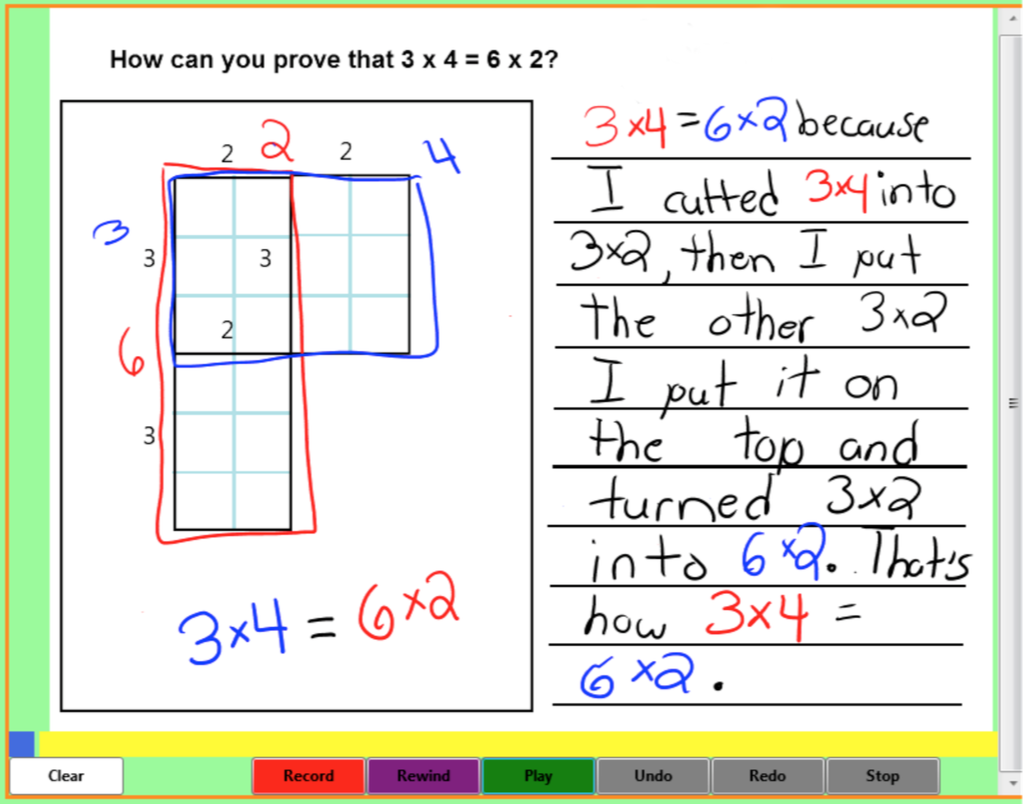
In this case, RO’s final image is more informative than the manipulations he performed to create it. RO has outlined the 6 X 2 array in red and used red to write 6 X 2 in his animation area. He similarly used blue to outline the 3 X 4 array and write 3 X 4 in the animation area. Interestingly, in his written explanation, he reversed the use of color, using blue for 6 X 2 and red for 3 X 4. He is, however, consistent in his use of color within each area.
While few students actually wrote down a statement that "the quantity had not changed, just the arrangement of the arrays," the teacher led the class discussion in that direction and at least one student included the following in his work, "The arrays are different sizes but have equal numbers." (By "size," he means "shape.")
All but a few students were successful in creating animations to prove this equivalence. Several students went on to make up their own, similar problems, such as showing that 5 X 2 = 10 X 1 or 6 X 6 = 12 X 3.
Problem 2 What happens when you subtract 1 from one of the factors in a multiplication problem? Create an animation to show what happens.While this problem was stated as a general question, we decided in consultation with the teacher to pose it about a particular multiplication problem to begin with; we used the problem 6 X 4. We planned to move to the more general problem statement if we had time, but we did not.
The key insight we hoped students would have in working on this problem is that subtracting 1 from one of the factors can be modeled by subtracting a row or a column from the array representing the original multiplication problem. Some students initially thought that they could model "subtracting 1 from a factor" by subtracting 1 from the product. In fact, for better or for worse, our software made this impossible, since using the scissors on an array automatically cut off some number of rows or columns. However, we observed at least one student (JA) trying – unsuccessfully -- to cut off a single unit (cell) from an array. Her eventual solution to the problem is shown in Figures 4a-c and Video 4, showing the beginning, middle and end of the animation she created.
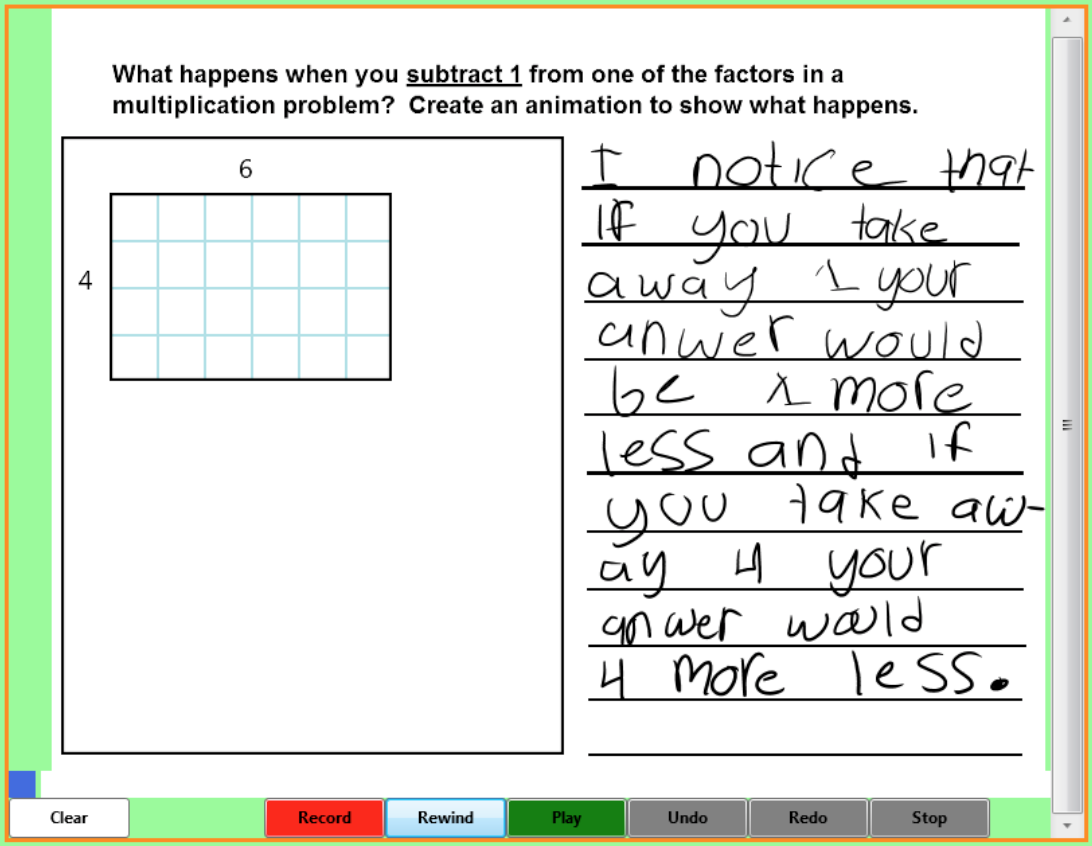
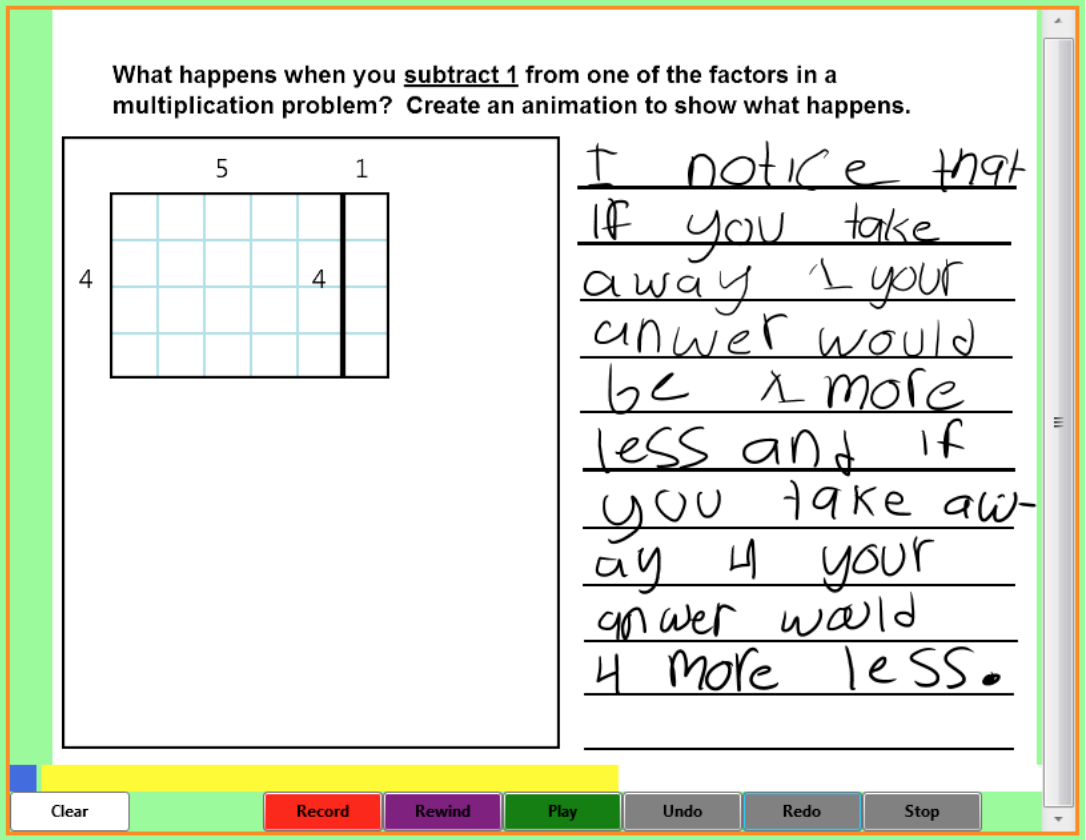
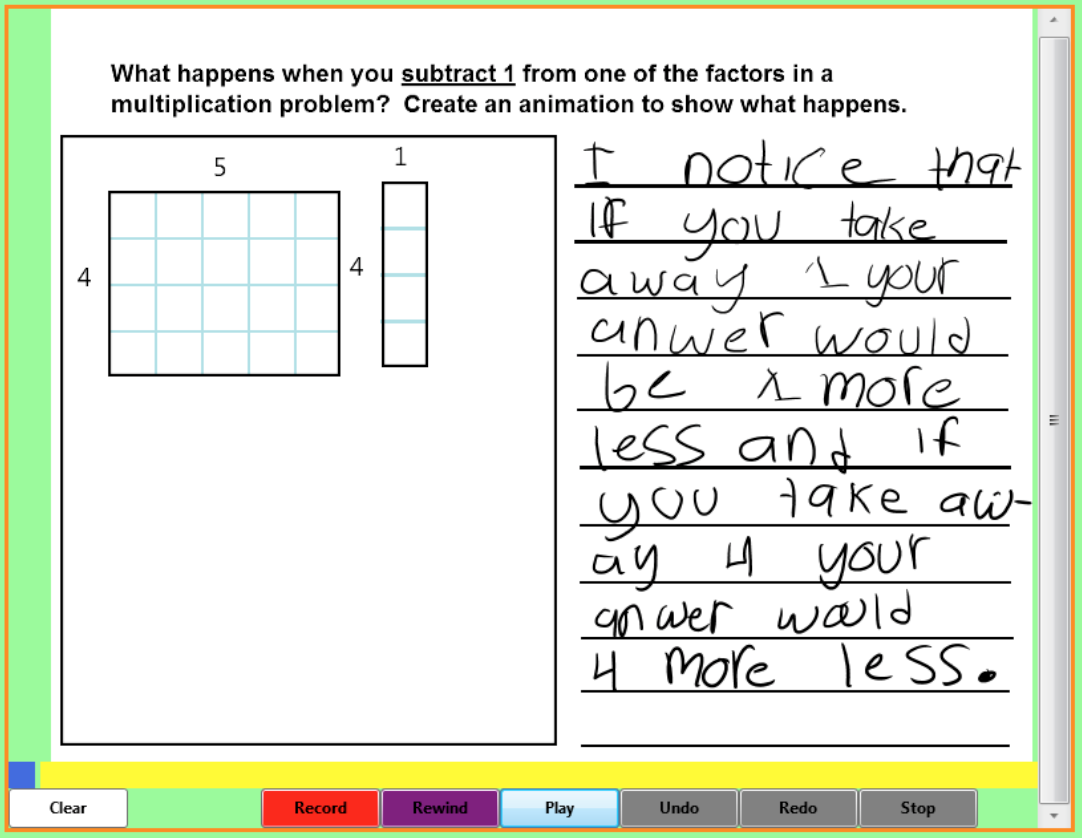
She cut off one column from the 6 X 4 array and moved it to the side. Her written explanation offers a window into her struggles: "I notice that if you take away 1 your answer would be 1 more less and if you take away 4 your answer would be 4 more less."
While many of the students created animations similar to JA’s, cutting off and moving either a row or a column, several students saw an additional level of complexity in the problem and realized that they could subtract one from EITHER factor, ending up with two different array manipulations. ME, for example, created two 6 X 4 arrays, cut a row off one and a column off the other and wrote, "I started with 6 X 4. I cut one of sides of 6 X 4 and made it into a 5 X 4. When I cut the other one I took the top one and it made 6 X 3." His animation is illustrated in Figures 5a-c and Video 5.
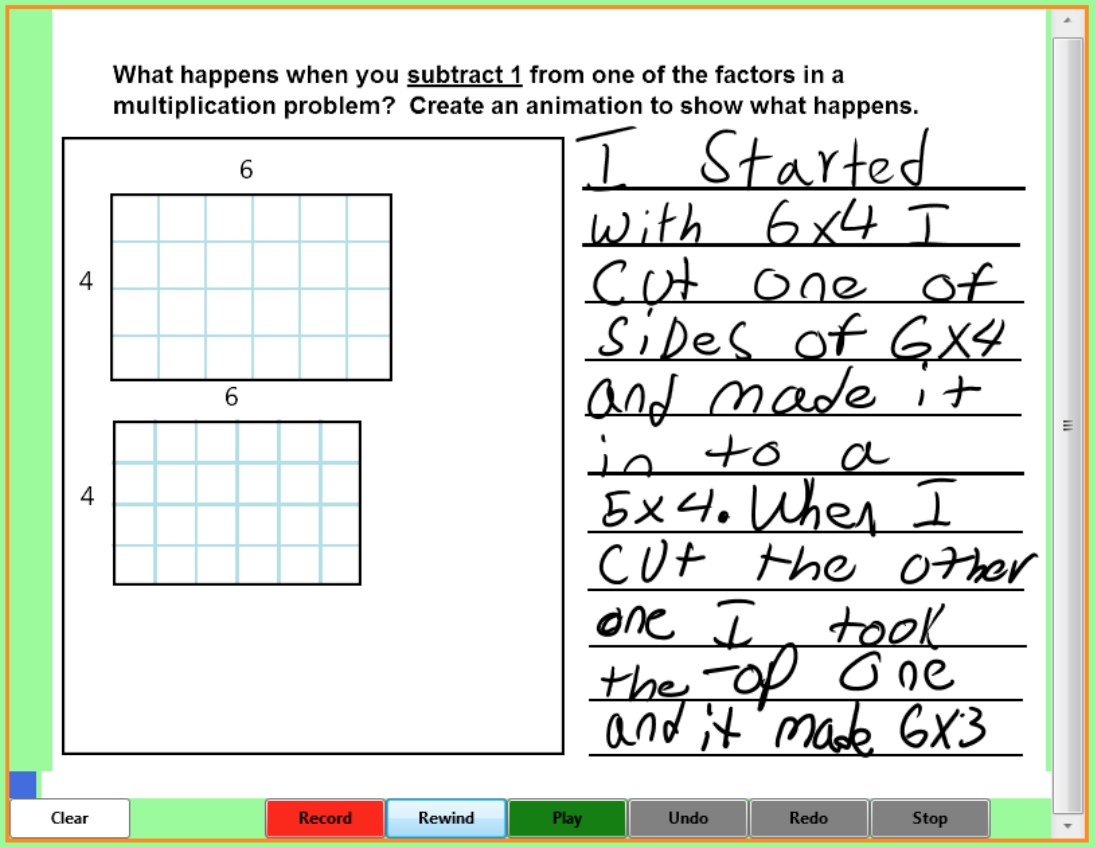
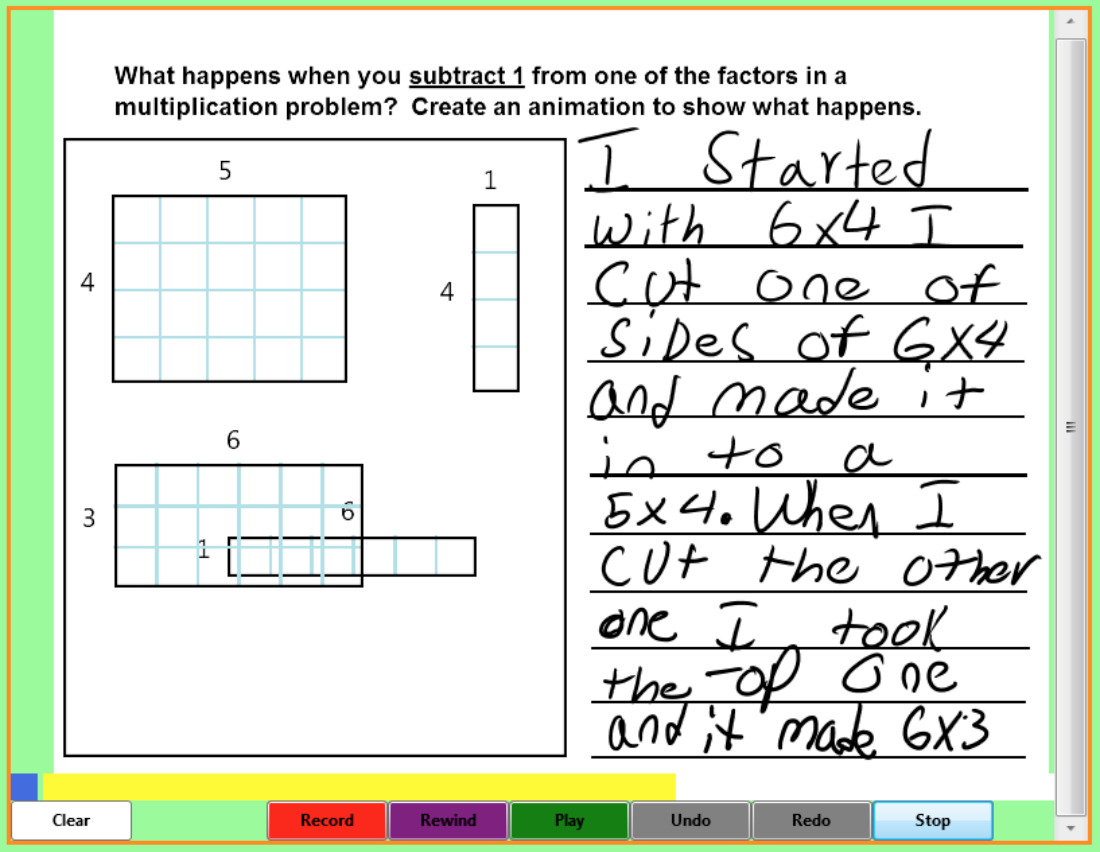
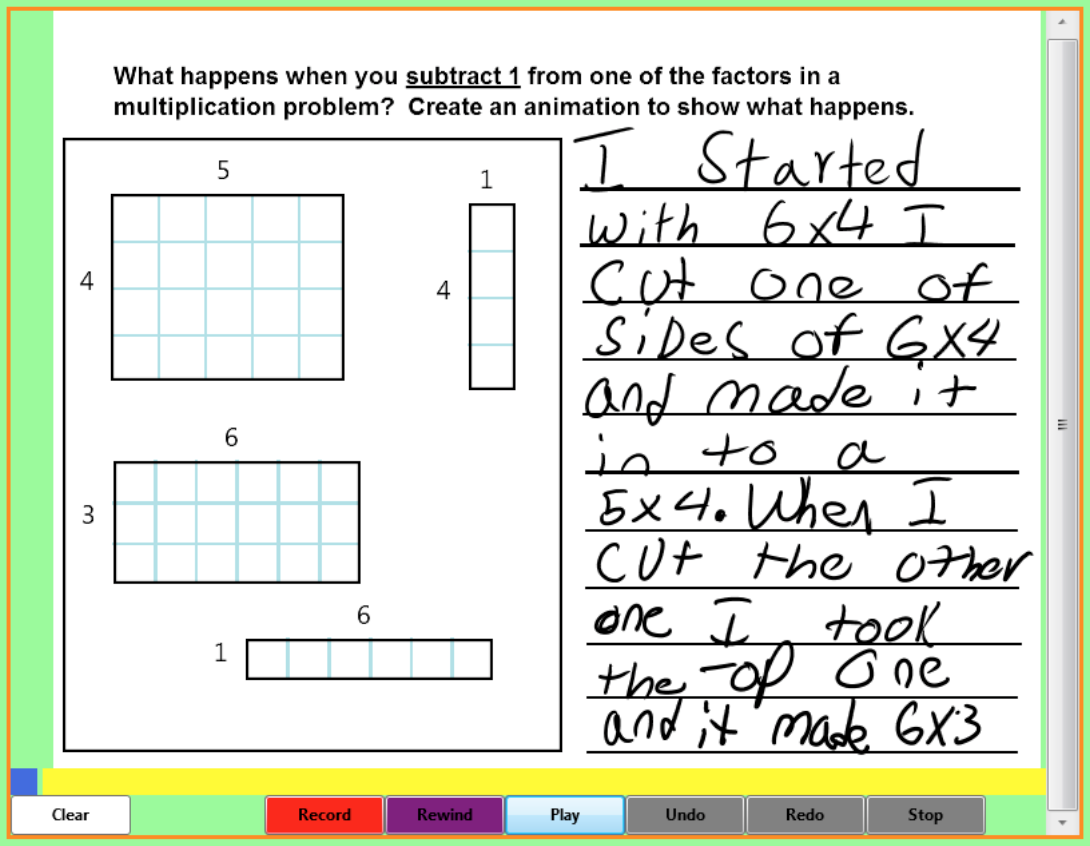
RO continued his use of color to illustrate his thinking, as shown in Figures 6a-c and Video 6, although the correspondence between ink color and the part of the problem it refers to is inconsistent.
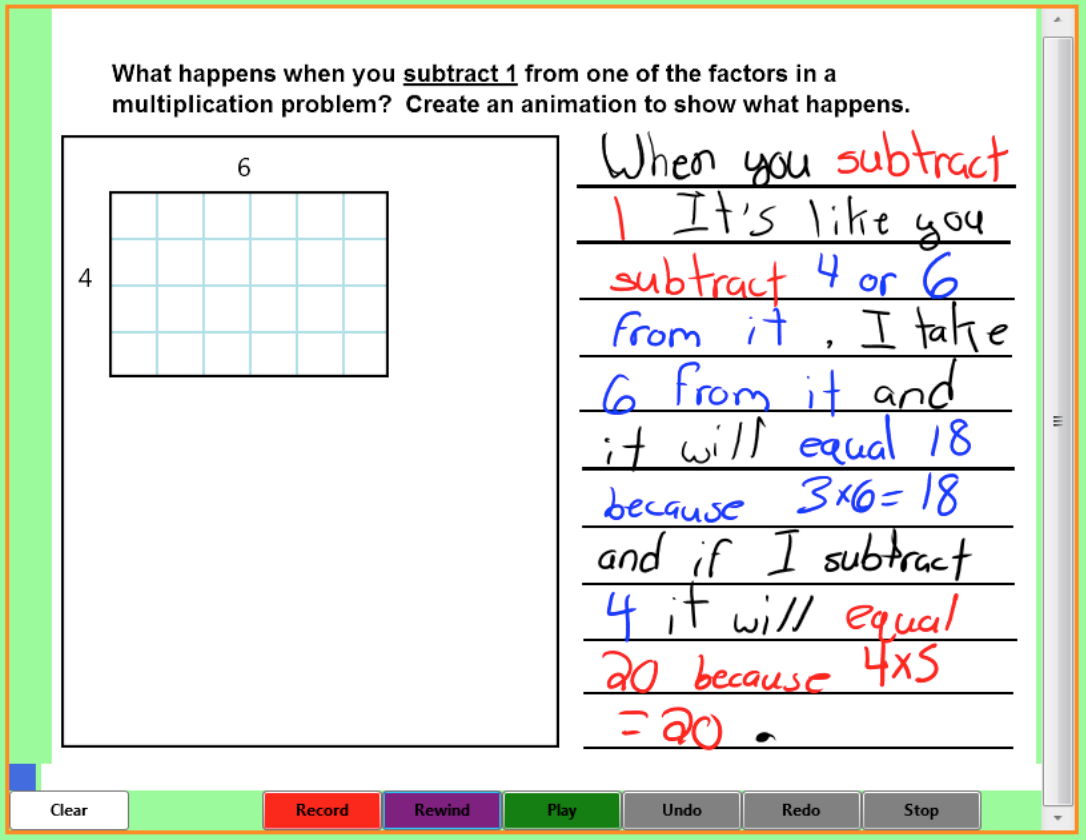
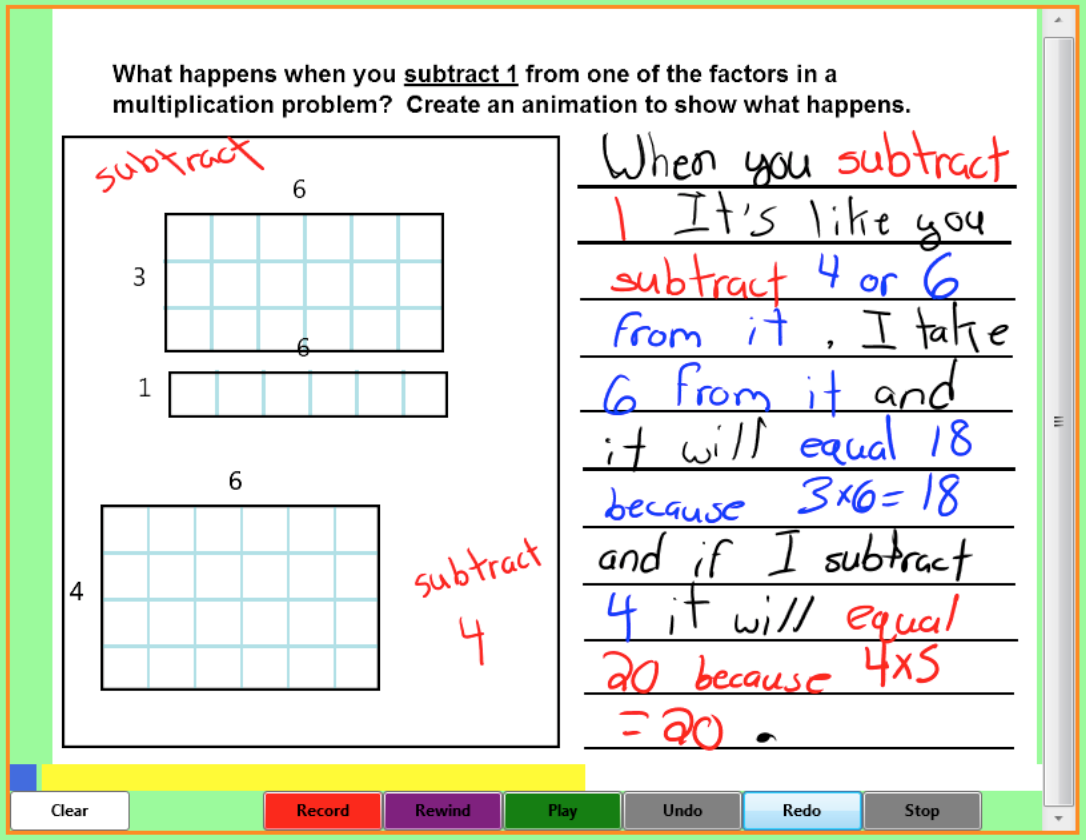
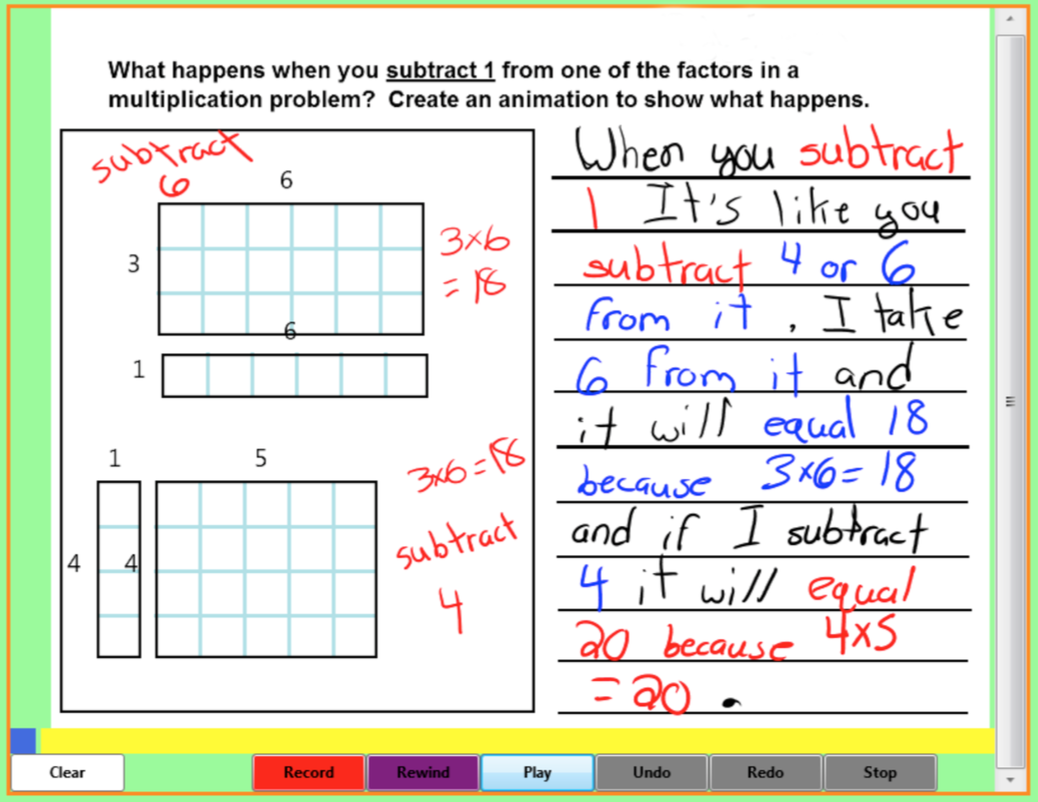
Like ME, he created two 6 X 4 arrays, cut a row from one and a column from the other. He took his thinking one step further, however, in noting what the final products were and how each differed from the original answer of 24. He wrote, "When you subtract 1 It’s like you subtract 4 or 6 from it. I take 6 from it and it will equal 18 because 3 X 6 = 18 and if I subtract 4 it will equal 20 because 4 X 5 = 20." (His picture is actually mislabeled, but his text is correct.)
DE, whose work is shown in Figures 7a-c and Video 7, added a dramatic flair to his solution by cutting off a row, moving it away from the original array, then deleting it.
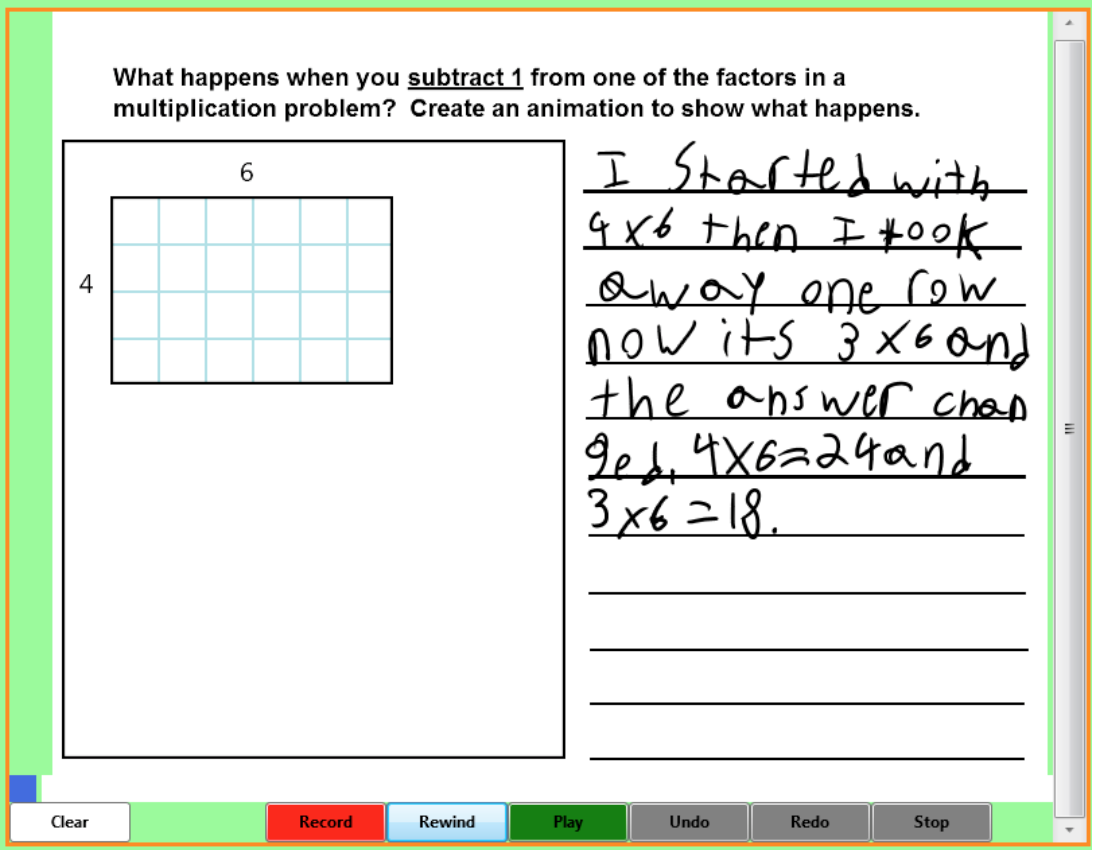
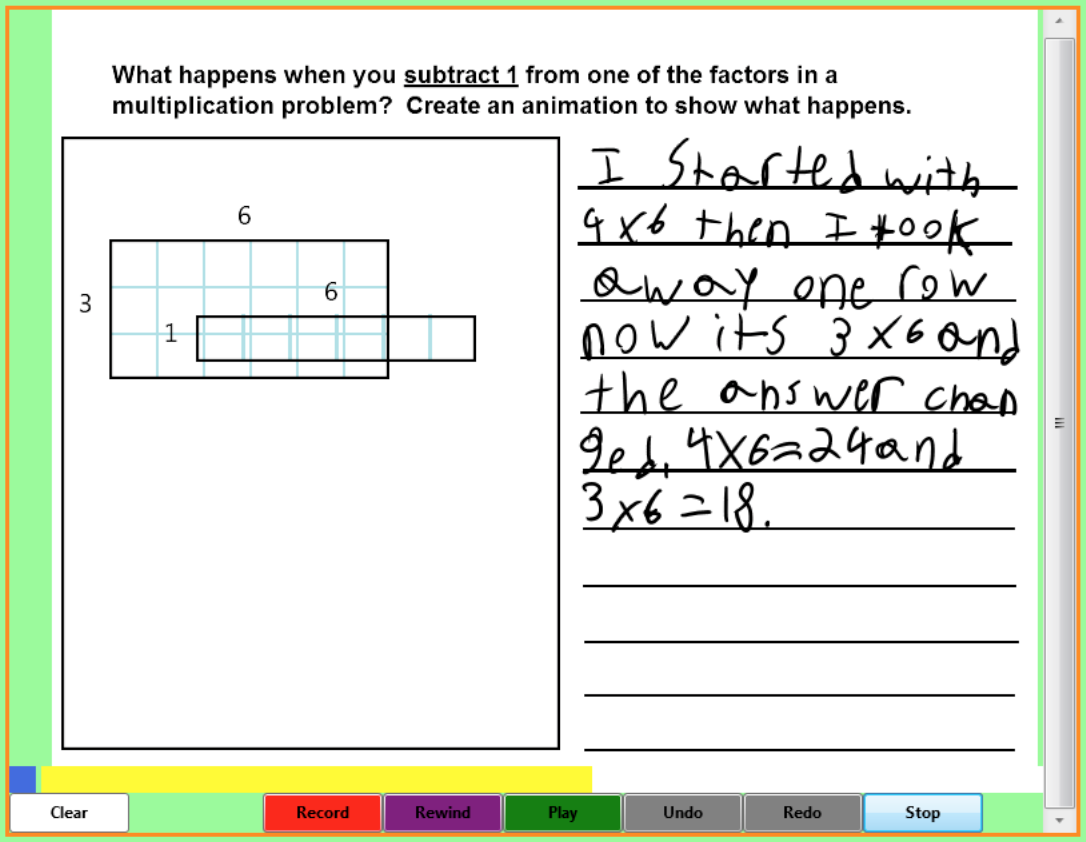
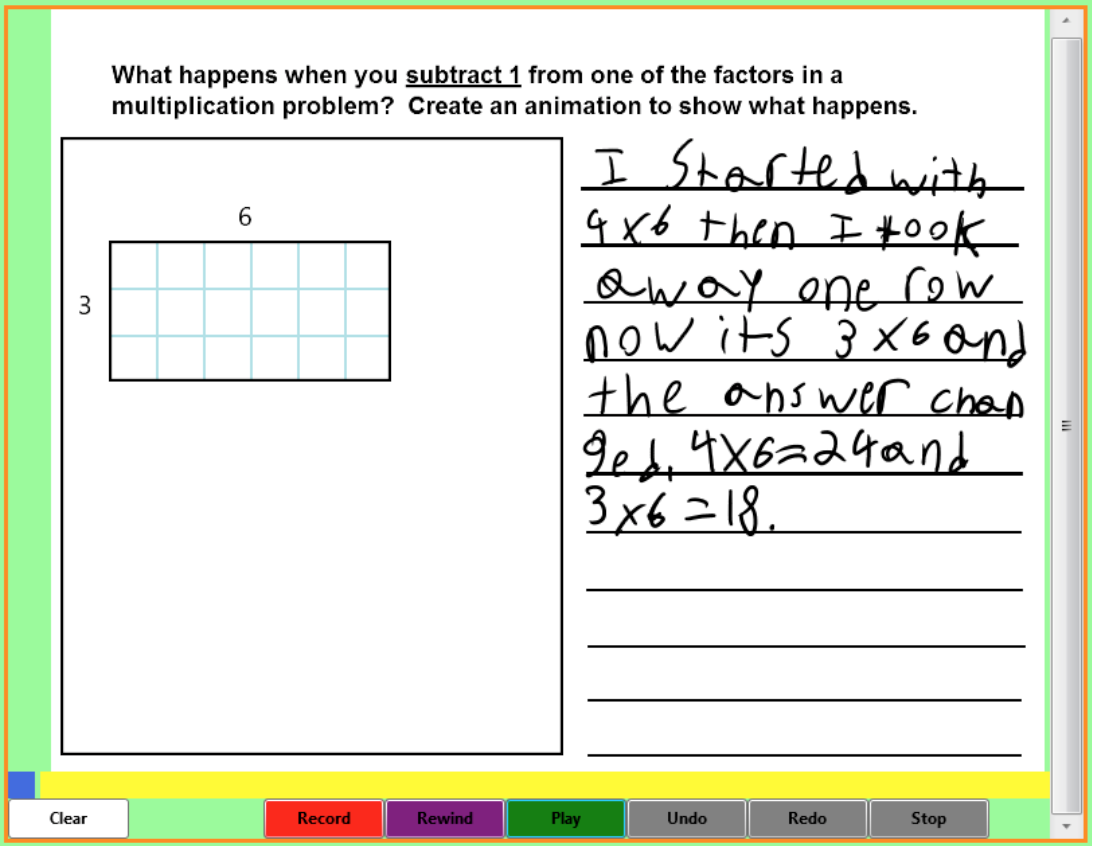
During the class, he was adamant that we display his work on the projector, so in the last few minutes of class, we did – and the disappearance of the cut-off row was greeted with appreciative laughter from the other students and the teacher.

About the Class: We visited this class because we wanted to know if the new cutting and animation software tools were accessible to struggling students: Could the students understand the concept of cutting arrays? Could they easily move the new small arrays on the screen? Could they understand the concept of creating an animation that explained their solution to a problem?
We had worked with these students on several previous occasions so the students were familiar with the CLP software and needed no introduction to using the pen or creating arrays. Unlike the students in Trial 1, these students had not been introduced to the idea of proof, so on the first day, we introduced the new software features—the cutting tool and animation—in the context of math problems familiar to the students, namely division with remainders. Then on the second day we introduced the idea of proof and had the students create animations for proofs similar to some of the proofs in Trial 1.
The students worked division with remainder problems, three problems that involved cutting and moving parts of arrays without animation and one that involved creating an animation.
Figures 1a-b and Video 1 show how one student created an animation to show his solution for this problem.
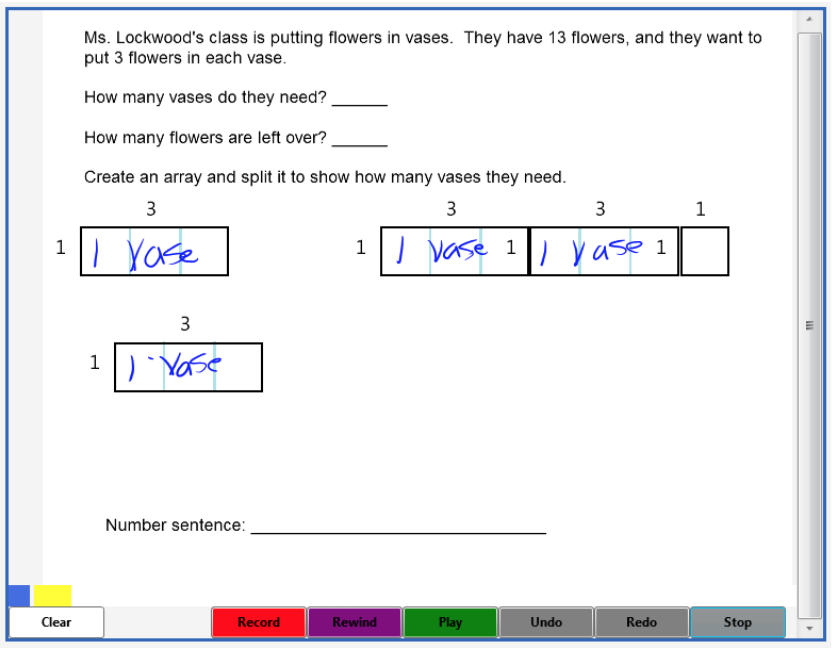
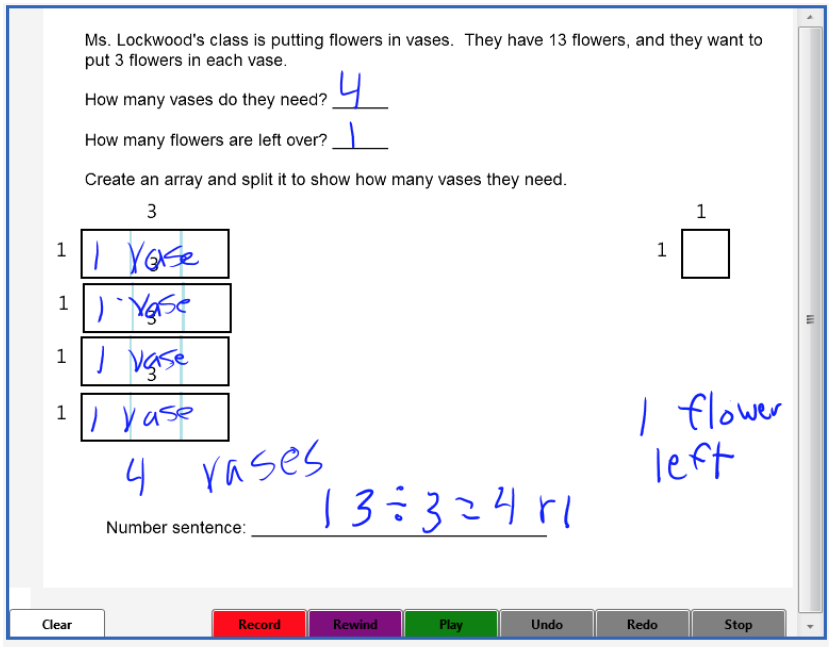
The students were given a 1x13 array to start the problem. In this example, the student tapped on Record, then cut the array to represent putting four flowers in each vase, moved the smaller arrays that represented vases together, and determined that there would be one flower left over. He then sent his notebook page to the teacher, who was able to view and play the animation on her machine and on the projector machine.
The students had no trouble using the new features. All the students but one were extremely engaged in using the animation tool and enjoyed seeing their work replayed for the class. One student created an animation for one problem, then decided for subsequent problems that having to tap on the animation control buttons slowed him down, so he didn’t create more animations. Instead he cut and moved arrays around and sent his final arrangement to the teacher. So animations may not appeal to all students, especially those who are impatient to be finished; we need further testing to know whether this one student’s experience can be generalized. (The teacher noted that this particular student had impulse control issues and often rushed ahead during assignments, generally understanding the math but often making careless mistakes in his haste.)
The students continued to practice making animations for three division with remainder problems, then created animations for three proof problems. For the first two of the proof problems, the students were given both starting and ending states, unlike the Trial 1 students, who were given only starting states. The reason for this change was because these students were special education students who benefited from working with concrete examples, and providing the ending state enabled them to more easily visualize the end of their proof. We intended for the students to turn the start state of an array into the end state. We observed that some students also turned the end state into the start state, showing their proof in both directions.
The proof problems were all what can generally be called a "double and half" proof: If you double one factor in a multiplication problem and half the other, then you get the same answer.
Figures 2a-d and Video 2 show one student’s work on this problem.
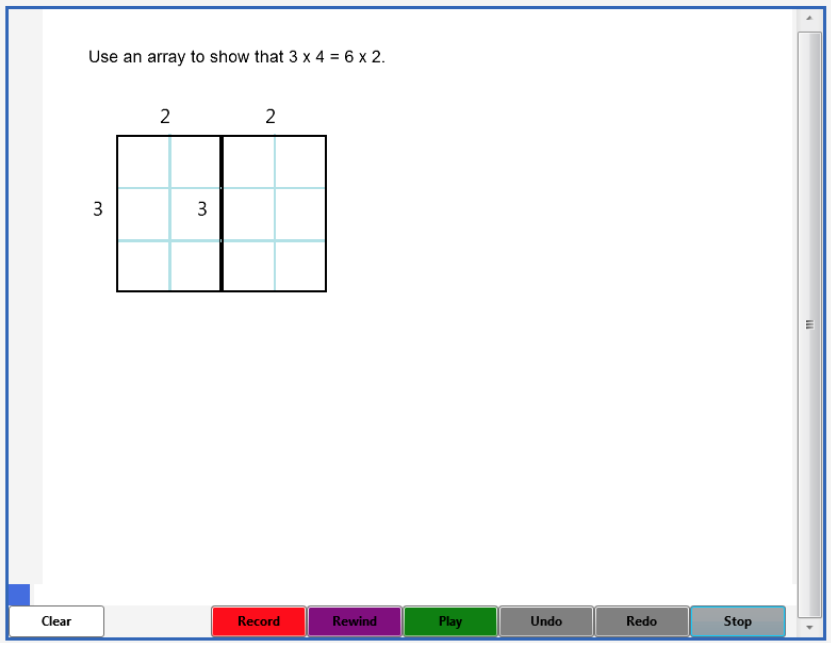
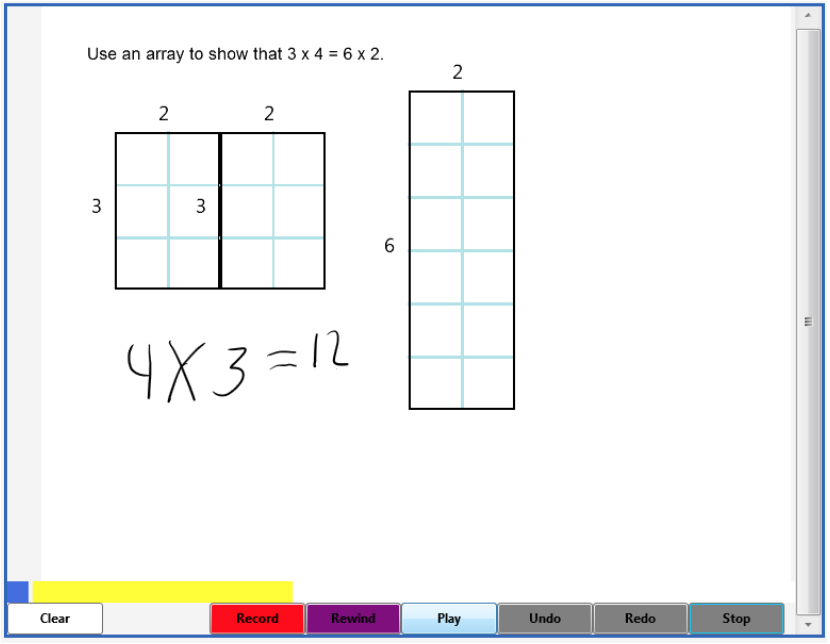
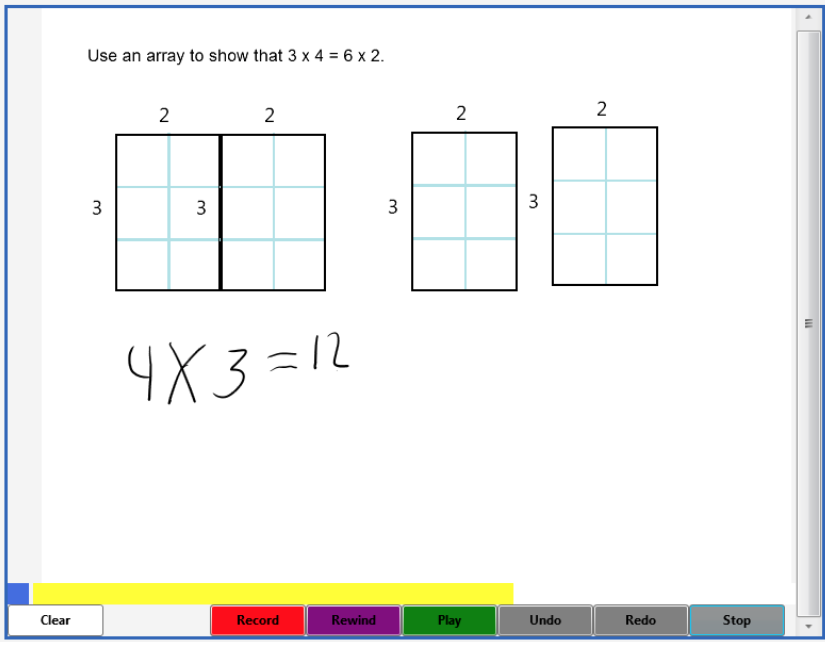
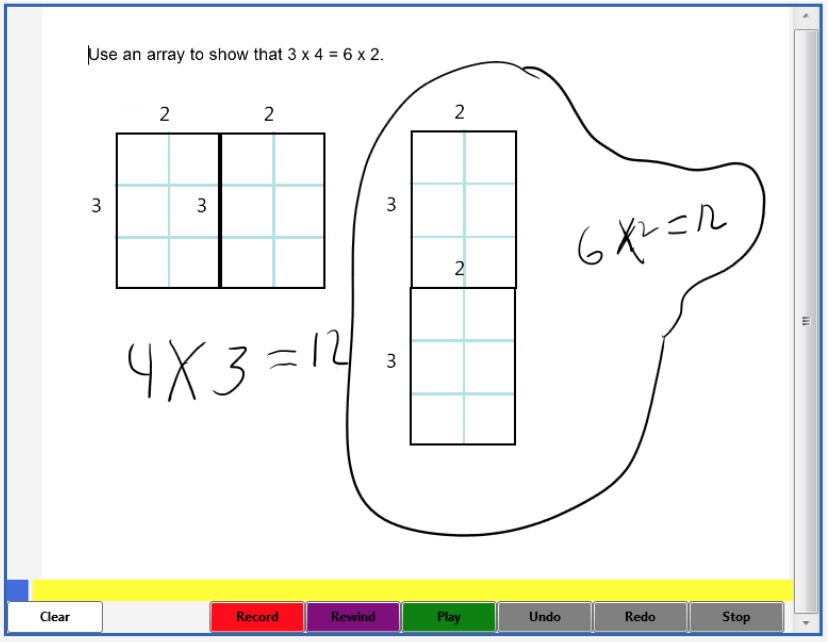
He began his animation by cutting the 3x4 array into two 3x2s. He then created a 6x2, cut that into two 3x2s, moved these arrays next to each other to show their similarity to the original array (now cut into two 3x2s), then realigned the arrays into the original 6x2 configuration. This student was very proud of his answer saying, "I showed it both ways!"
The other students were equally as successful, though the two fourth grade students needed some assistance from the teacher in figuring out the ending state. One of these students, who had attentional issues, became distracted and moved the arrays around randomly when he lost focus. Prompting from the teacher brought him back on task. He was able to clear his animation and start again.
Overall, we found that the answers to our original questions were yes: These special needs students easily used the cutting and animation tools, and they understood the concept of creating an animation as a solution to a problem.
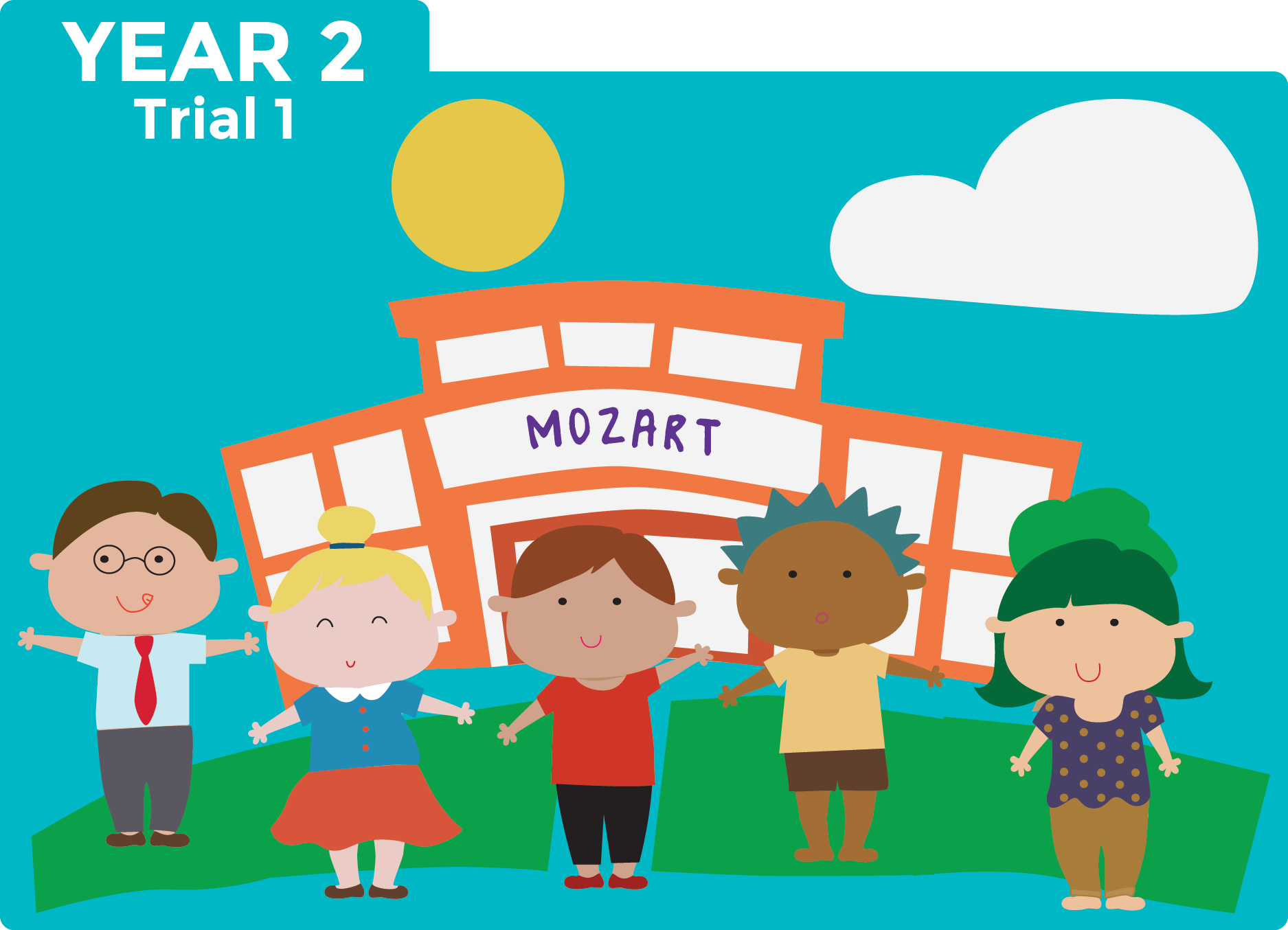
In this trial, we worked with the same teacher who hosted our Trial 1. For several years, she had been part of the NSF-funded Routines project, upon which our perspective on early algebraic reasoning is based. Thus, she had extensive experience guiding elementary school students in making generalizations about arithmetic operations. In our work with her last year, students were quite successful using the animation software to make statements about arithmetic equivalences, but never got to making arguments about generalizations about the way operations worked across "all numbers."
Our goal for this trial was to see if 4th grade students could productively discuss a generalization about arithmetic operations after a limited amount of time using our system to explore equivalences. Our target operation for generalization was multiplication for three reasons: 1) multiplicative structures are a key part of the fourth grade math curriculum; 2) there are a variety of interesting generalizations that can be made about the way multiplication works; 3) we have a robust set of tools for creating and manipulating array representations of multiplicative relationships.
Based on our experiences last year (Trial 1; Trial 2), we created a 3-day curriculum that introduced students to the array manipulation tools and the animation system, gave them opportunities to practice using the software to show the equivalence of several multiplicative expressions, then presented several instances of the "target" relationship we wanted them to generalize about. In general, students demonstrate the equivalence of two arithmetic expressions by creating an array representation of one expression, modifying it so that it represents the other one and noting that, while the two representations look different/have different shapes, no "squares" have been added or deleted, so the quantity represented has remained the same. Recording the transformation of one representation to the other using the animation system constitutes a type of representation-based proof, a term coined by Schifter, Russell and Bastable.
Students first created animations to prove these equivalences:
An example of a student proof of 3 X 6 = 9 X 2 is shown below, both in static form over three stages of the animation, as well as in the animation form.
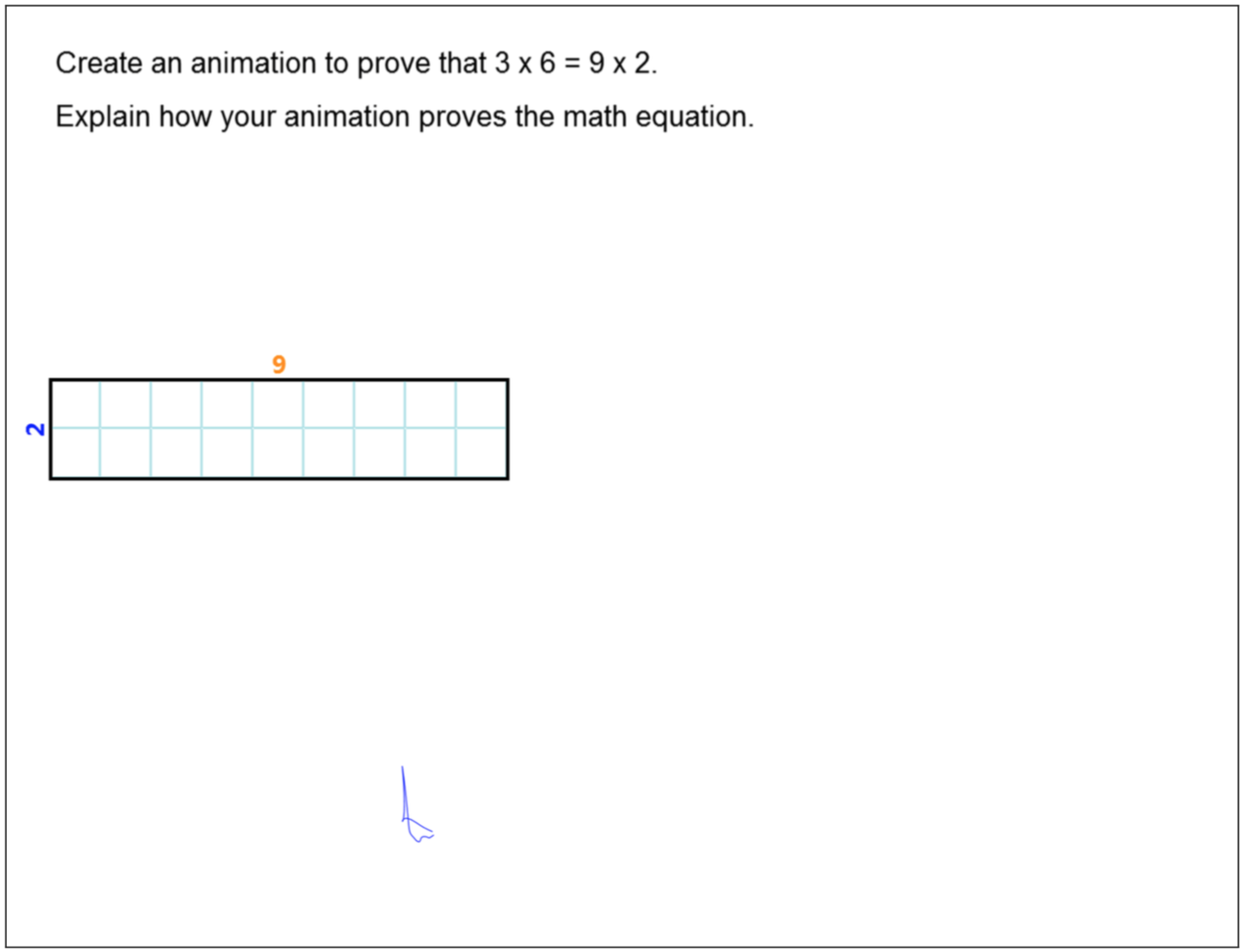
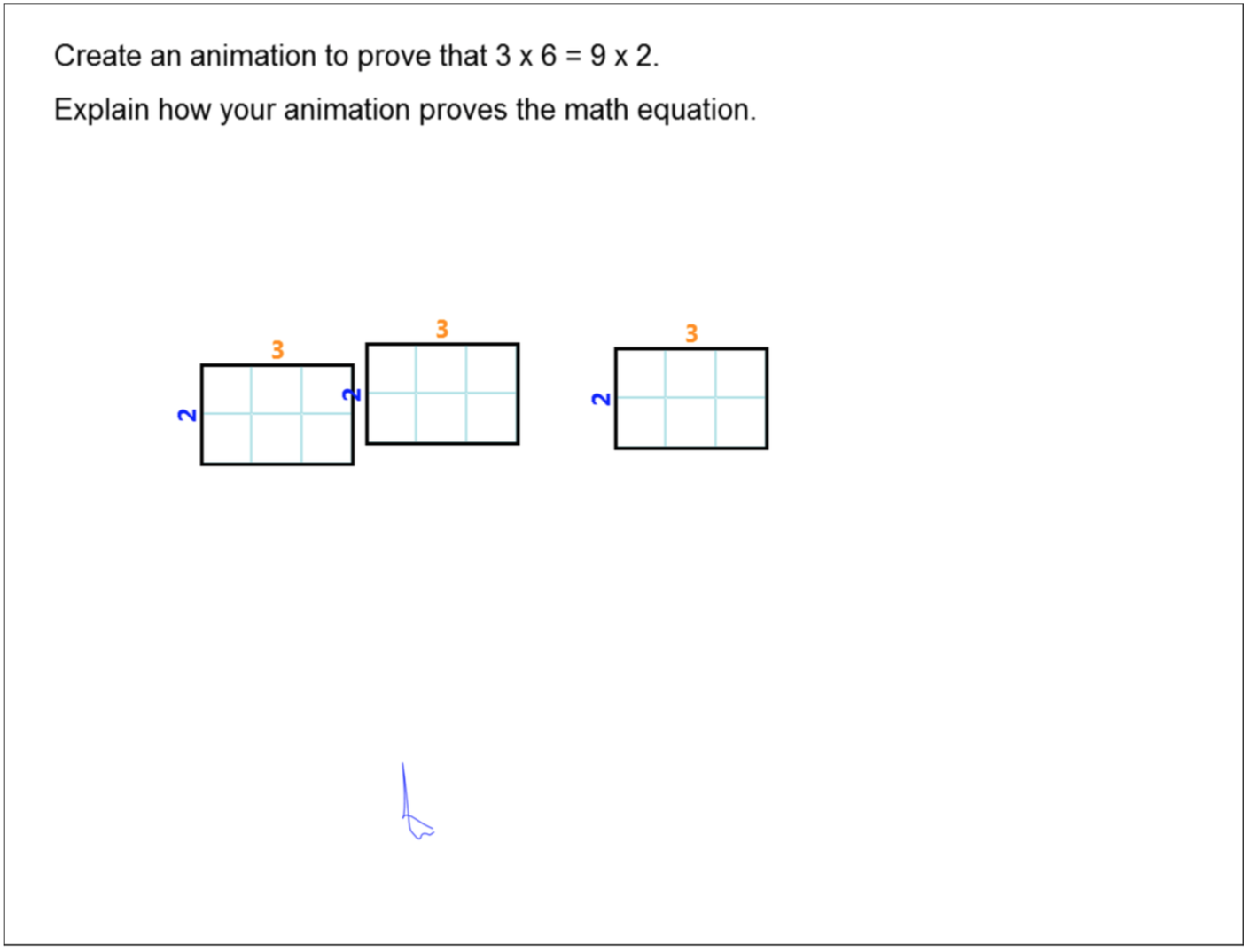
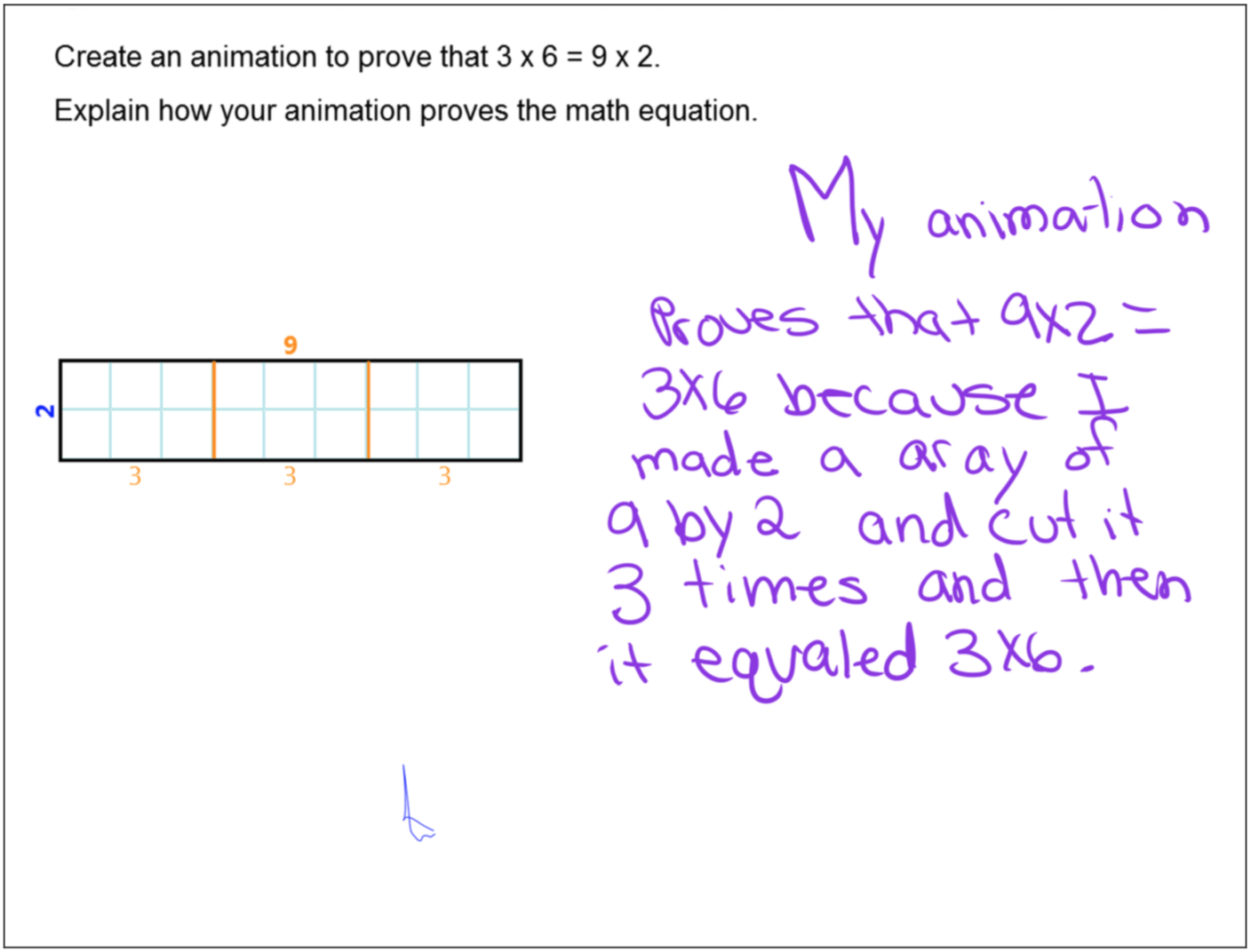
The student whose work is shown in Figures 1a-c and Video 1 began with a 9 X 2 array, then cut it into three 3 X 2 arrays, each of which had a total of 6 squares, thus representing 3 X 6. Other students actually "snapped" the three 3 X 2 arrays together to form a 3 X 6 array. Still other students began with a 3 X 6 array, cut it into three 3 X 2 arrays and reassembled them to form a 9 X 2 array.
When most students were fluent with these kinds of proofs, we moved on to the basis for the generalization.
The next three problems were: Create an animation to prove that...
Jan’s animation, shown in Figure 2a-b and Video 2, is typical of the proofs students produced.
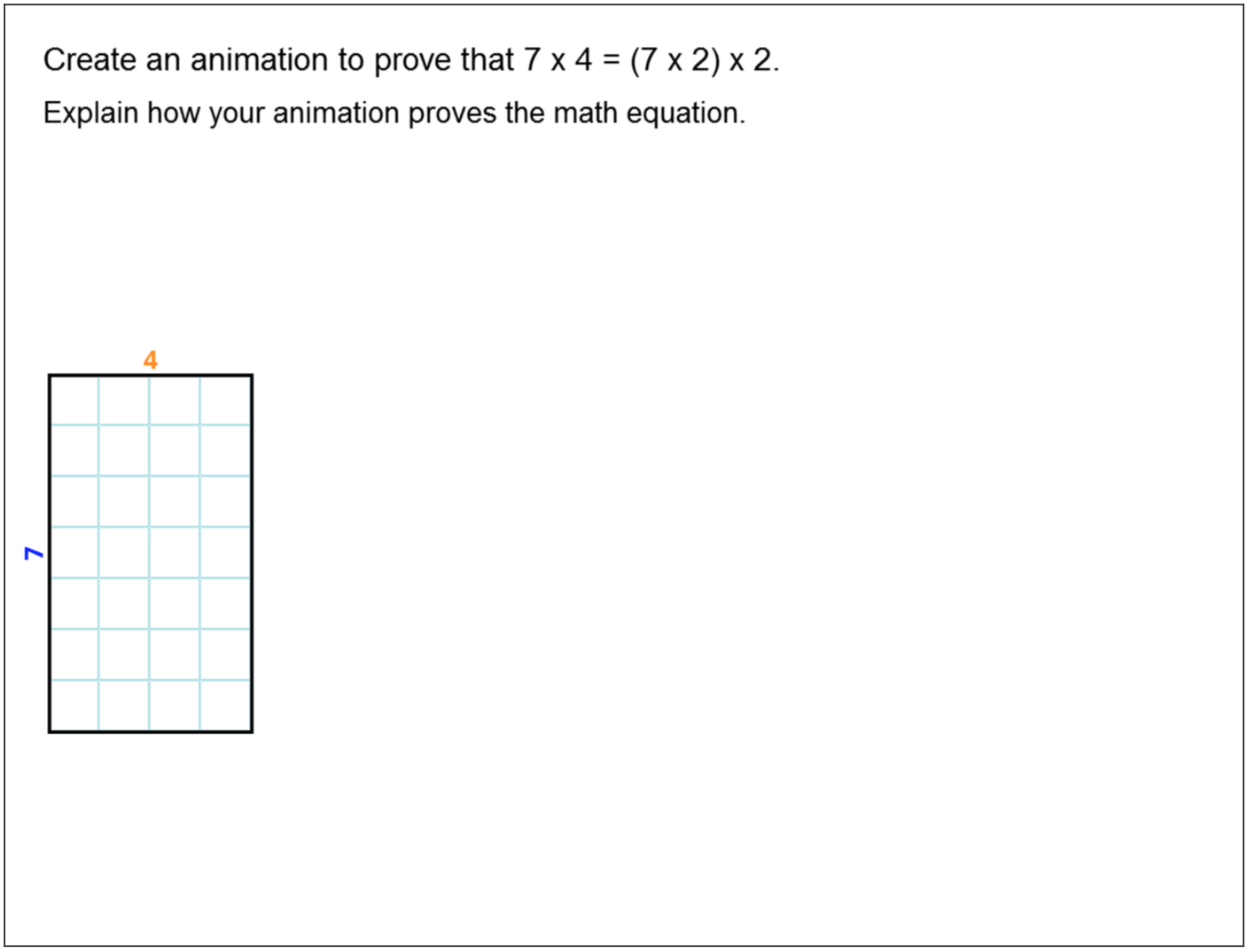
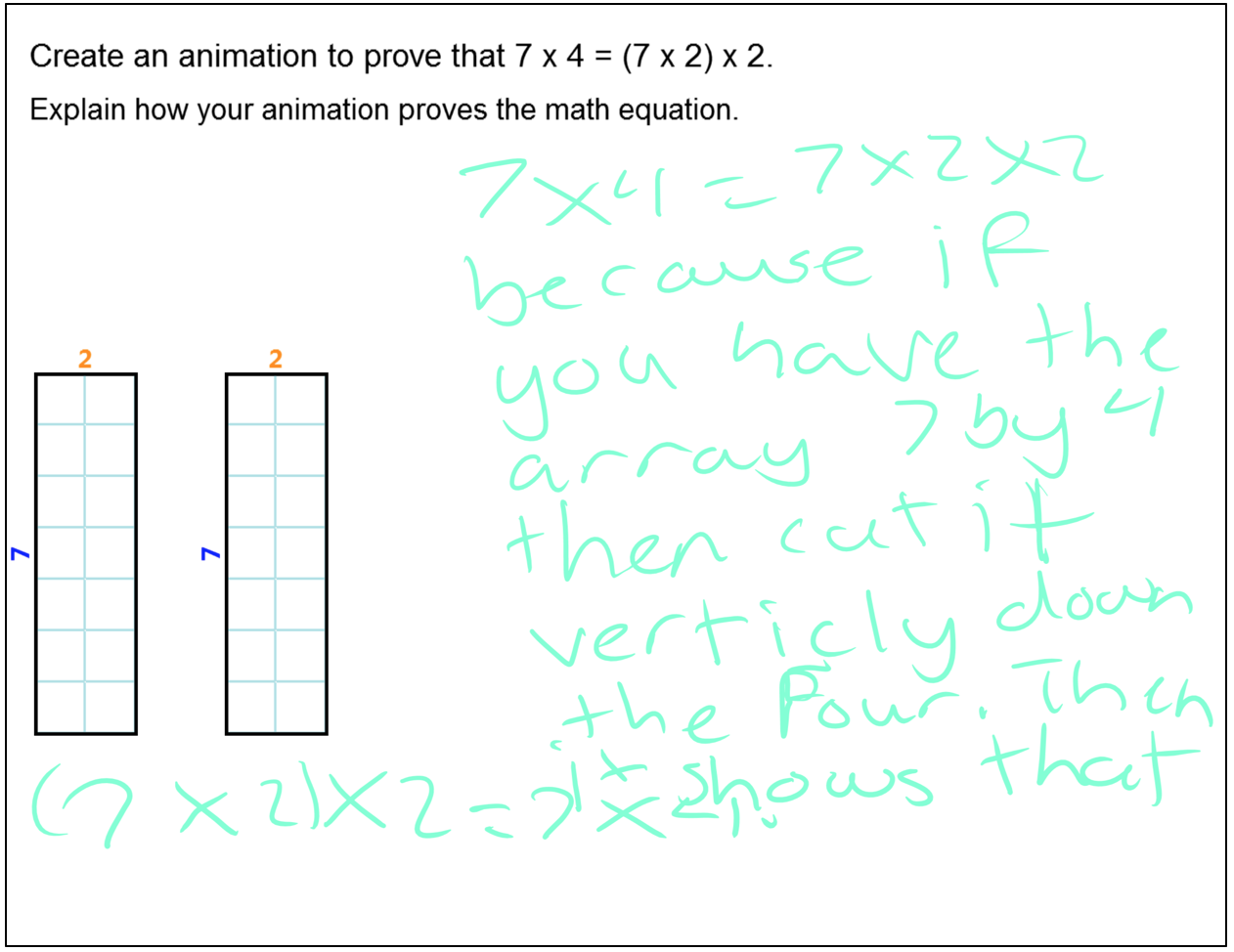
She started with a 7 X 4 array, shown in Figure 2a, then split it into two 7 X 2 arrays, as shown in Figure 2b. Her explanation is straightforward: "7 X 4 = 7 X 2 X 2 because if you have the array 7 X 4 and cut it verticly [sic] down the four, then it shows that (7 X 2) X 2 = 7 X 4."
After students explored these three parallel problems, we led them to think about the underlying pattern of which they were examples. What follows is a lightly edited transcript of the classroom conversation.
Ms. F (Teacher): So when you did all three of those, what did you notice about all of them?
Student 1: The 2 came up every time.
Student 2: When you have a big array, you always have to cut it in half to find the answer.
Student 3: I noticed that in every problem, it says that something times 4, and then they break up the 4s into 2s.
Ms. F: So she just said "something" times 4. So does that mean it’ll work with another problem?
Student 4: Yes, with an even number. All the problems started with an odd number.
Ms. F: Would it work with an even number?
Student 4: Yes. I did 52x4.
Student 5: It would still work because you still have the same numbers – 4x2. It doesn’t matter if it’s even or odd – you still would have the same thing.
Ms. F: What is the "it" that we’re talking about? What are we doing?
Student 6: We’re times-ing numbers by 4.
Student 7: I noticed that I had to cut it in half to times it by 2.
Ms. F: So whatever that big number is 7x4, 8x4, 100x4. We can take that big number, times it by 4, cut it in half, and it would be that big number times 2 times 2.
Ms. F: Are there any odd numbers it wouldn’t work with?
Student 8: It wouldn’t work if you switched the 4 and the 3 (i.e. "turned the 4 into a 3").
Ms. F: Because the two 2s wouldn’t equal the 3?
Ms. F: What if we changed the 7 into 175, or some random number? Would that work?
Some students: No.
Ms. F: Why not?
Student 9: Because it’s too big.
Ms. R (researcher co-teaching): How many people think it’s too big? Let’s take a vote. How many people think you can still prove that 175x4 = 175x2x2.
Most kids say yes, a few say no, some say they’re not sure.
Student 10: if you do the multiplication, you get the same answer.
Student 11: It would work because if you have 175x4. You have the 2 and 2 and that would be 4. And you just leave the 175 the same.
Student 12: It would work with any number, because it’s still times-ing it by the 4, and the 2 and the 2.
Student 5: The first number could be either even or odd, as long as the 4 and the 2x2 is the same.
Student 11: It would be the same for any number, because 2 is half of 4, so you just double it, and you’ll get the same answer.
Most of the class was convinced at this point that the equivalence would work for any number. While they were not able to create an animation to show the equivalence for "any number," it was clear to the adults in the class that the students were basing their arguments on the examples they had just worked. Students successfully made the crucial distinction between the parts of the equivalence that could change ("it would be the same for any number"; "the first number could be either even or odd") and the parts of the equivalence that could NOT change ("as long as the 4 and the 2X2 is the same"; "because 2 is half of 4, so you just double it").
We concluded the class by telling the students that they had just done algebra, which impressed them, since they considered algebra a complex math topic reserved for middle and high school students.
